Paul Weimer went to donate some books at Don Blyly’s new location for Uncle Hugo’s and Uncle Edgar’s bookstores. While he was inside Paul shot these photographs of the bookshelves being stocked and other work in progress.










Paul Weimer went to donate some books at Don Blyly’s new location for Uncle Hugo’s and Uncle Edgar’s bookstores. While he was inside Paul shot these photographs of the bookshelves being stocked and other work in progress.









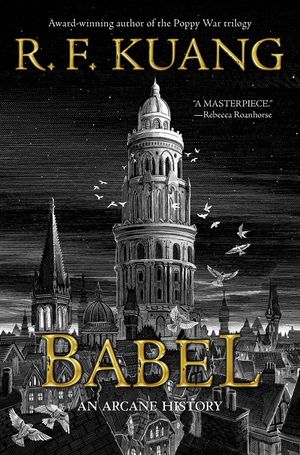
By Paul Weimer: R F Kuang’s Babel is an audacious and unrelenting look at colonialism, seen through the lens of an alternate 19th century Britain where translation is the key to magic. Kuang’s novel is as sharp and perceptive as it is well written, deep, and bears reflection upon, after reading, for today’s world.
The word essay derives from the French infinitive essayer, “to try” or “to attempt”.
The word review is also ultimately French. Middle English reveue, from Middle French, from feminine past participle of revoir to see again, reexamine.
This is a review, and essay, where I try to attempt to talk about BABEL: Or the Necessity of Violence: An Arcane History of the Oxford Translators’ Revolution, by R F Kuang.
The time and place is a very slightly alternate 19th century Britain. In this world, there is one form of magic. It turns out that silver engraved with two words in different languages that have the same meaning can derive a magical effect because no two words have the same exact meaning and that difference can be exploited.
Take the English word speak, and take the Latin word iacto. Iacto means speak, but it also means to cast, to hurl. One could use a silver bar with those two words engraved, by its magic, be able to speak more loudly, to cast one’s words out further.
The English Empire has the premier translation facility in the world and is always looking for more translators, especially in more far-flung languages. As languages blend and meld, the difference between words in different languages gets smaller, and so the magical effect becomes less efficacious. Also, people need to be able to think and be immersed in both languages to make the magical silver bars that function. Those silver bars do everything from improving fighting vessels to giving additional stability and robustness to carriages and railroads to providing magical healing and aid.
And so we are thus introduced to our main protagonist, Robin Swift. Rescued from poverty in Canton after his mother’s sickness and death, by his new guardian, Professor Lovell. He is trained in Latin and Greek, but it is his knowledge of Chinese and English where his talents lie. The differences in translation between the two languages, in someone who has those languages so firmly in their thinking mind, provides a potential wealth of new translation pairs that the British Empire wants…and needs. And so Robin is set and polished and readied to attend the Royal Institute of Translation, the titular Babel. As Robin bonds with other members of his class at the fictional University in the city of Oxford, he soon begins to learn the cost of Empire…and what Babel will do to maintain that power…and what he is asked to do to maintain that power.
Especially as what our world calls the Opium War is brewing.
And so a story is born.¹
Story. Middle English storie, from Medieval Latin historia narrative, illustration, story of a building, from Latin, history, tale; probably from narrative friezes on the window level of medieval buildings.
Having a Chinese would-be translator brought to the heart of the British Empire, and he and his friends’ talents aimed toward maintaining the Imperial Project, swings for the fences in terms of themes, and this novel’s strength is in the themes it ruthlessly interrogates. Colonialism? Empire? Oppression? Racism (in fact, three out of the four in Team Babel are POC)? All of these. Two of Robin’s comrades are women, and so we get a (man’s) view to Sexism as well. Kuang makes a really good point on how these toxic -isms are all interconnected, intertwined and feed off of each other to produce truly terrible results. Readers of The Poppy War trilogy know that she doesn’t pull punches when it comes to the costs of War and oppression. If anything, her words are even sharper here.
The novel is grim, dealing with some very dark subjects, and it is in the end very much not a happy story. Again, readers who have read her previous trilogy know to expect this from Kuang, but readers who are coming to her here, fresh, should learn to expect it. Are there moments of fun, of levity? Sure. Is there an absolutely bonkers level of geekery and joy in the idea and nature of translation? Does the novel take absolute pleasure in how things are translated, and what that means (above and beyond even the magic of the silver bars?) Certainly.
In point of fact, if you want to go back to the theme, and this novel does hammer then, so you might as well, then for the three POC of the four main characters², their very lives and natures are an exercise in translation. Robin is “translated” from Canton. Ramy is a translation from India. And finally, Victoire is a translation from Haiti. Those translations from their previous lives to their current ones have all gone differently, and not perfectly, either, because the whole point of the novel and the idea of translation and its magic is that while these cognate words might ostensibly mean the same thing, in reality, they do not. There is difference, divergence, and change.
And the novel understands the nuances involved. Robin gets into an argument with Professor Lovell, who is appalled when Robin seems “ungrateful” for having been rescued by him from destitution, poverty and death to a life working for Babel. Robin’s reply, aghast, is that he could have saved his mother from death–and chose not to. Colonialism and the colonial project, imperialism all degrade both the oppressors and the oppressed. And Kuang follows the logic of that, and responding to that, all the way to rebellion and revolution.
Consider the subtitle “Or the Necessity of Violence: An Arcane History of The Oxford Translators Revolution”. This points to where the novel is going, which, like The Poppy War, starts off as a story of Robin escaping his previous existence, learning, and growing, and then by degrees both large and small, being thrust into taking violent, dangerous action. And, again, given that this is a Kuang book, there are costs, personal as well as societal, to taking such large scale, drastic action. In this summer of 2022 when the book is being published, given the political moment here in the United States, you bet that this novel resonates like a bell.
One thing that does disappoint me in Babel, though, and it may be an idiosyncratic affectation on my part, and it is what I call the “Temeraire Problem.” Temeraire, if you will recall, is the series of Naomi Novik novels that can be high concept pitched quite accurately as “The Napoleonic Wars with Dragons”3. And while the events of the Napoleonic Wars do diverge from our own history in the writing of the novels, all the millennia of history previously, somehow, was all the same as our own. With such a major change to the world as having Dragons, for World history to have gone the exact same way without discernible change seems like a failure of imagination, or a reluctance to go down the rabbit hole of what changes could and would possibly happen to the timeline. And so, really, nothing has changed.
While I can see the value of doing this for the reader, as well as it reduces the ask for the reader in accepting changes beyond the high concept and its immediate consequences, it makes the worldbuilding feel more like a copypasta of history, but with an additional added element. In Babel, we have magic, verifiable magic that has been around as long as there have been multiple languages. And yet for all that, in early 19th century Britain, everything has gone, as far as I can tell, as a carbon copy of our own world. I suppose it is possible that unseen corners of the world that our protagonist has not seen or read about, but the impression that the novel gives is that this is a Britain (and China) on the verge of the Opium Wars, and there are no complicating and entangling factors to distract from looking at that narrative as effectively as it does as outlined above. But a world where engraving silver with translated worlds is magic, there are potentially huge changes to history at a number of points that could set the entire course of history differently.⁴ And even if you didn’t want to play in super major keys with that, acknowledging how silver and translation’s magic has affected history in the past would help set up what happens in the “present” of this novel even better.
With that disappointment in mind, and again, your mileage may vary in what you expect from alternate historical fantasy, Babel is a fantastic and engaging read. Kuang interrogates colonialism, language, resistance and revolution, culture, and an underused portion of history (in genre) to sharply make her points and tell an engaging and complete story in one (relatively thick) volume. The book is, to use an overworn phrase, a leveling up of Kuang’s already honed talents from the Poppy War trilogy. Kuang is a rising talent within genre and Babel is an excellent place to discover her work.
Babel: Or the Necessity of Violence: An Arcane History of the Oxford Translators’ Revolution, Harper Voyager, 2022
¹It should be noted, that as befits a work that is set at an academic bastion of translation and knowledge, that the book has plenty of footnotes.
²The fourth of the students, Letty, is a young woman from England. Kuang makes good use of the difference between her and her three compatriots. The rich character possibilities are not squandered, but to say more would be highly spoilery.
3Or perhaps a little more accurately and narrowly still, It’s Jack Aubrey (Master and Commander) with Dragons
⁴Off the top of my head, societies with a lot of silver and the potential to use its magic that could have changed history in significant ways: The Athenian Empire, the Carthaginian Empire, the New World and the Spanish Empire (Kuang kind of thinks of going there but doesn’t quite manage it). Also historically, Japan traded (often indirectly) with China using silver.
(1) CHARLIE JANE ANDERS KEYNOTE OPENS EVERY DOOR. In “Children’s Institute 10: Charlie Jane Anders Says ‘Magical Portals Exist, and Adults Aren’t Real’”, Publishers Weekly has extensive details of the author’s talk.
Science fiction author Charlie Jane Anders (Victories Greater Than Death) brought abundant charisma to the stage for her Ci10 keynote. Her hot-pink bob, matching Doc Martens, and neon-confetti-dotted black dress reinforced her energy. She delivered her talk, “Magical Portals Are Real, and I Can Prove It!,” in a conversational and confiding tone, to booksellers who know and recommend her LGBTQ+ fiction.
Alluding to Frank Herbert’s Dune dictum that “the universe is full of doors,” Anders said that we encounter portals in our lives. “I’ve jumped universes three or four times,” she said, acknowledging how she came to recognize her authorial persona and trans identity. “This is definitely not the universe I was born in.”…
(2) FINAL SCORE? Indiana Jones 5 might be it: “John Williams, 90, steps away from film, but not music” – reports the Associated Press.
After more than six decades of making bicycles soar, sending panicked swimmers to the shore and other spellbinding close encounters, John Williams is putting the final notes on what may be his last film score.
“At the moment I’m working on ‘Indiana Jones 5,’ which Harrison Ford — who’s quite a bit younger than I am — I think has announced will be his last film,” Williams says. “So, I thought: If Harrison can do it, then perhaps I can, also.”
Ford, for the record, hasn’t said that publicly. And Williams, who turned 90 in February, isn’t absolutely certain he’s ready to, either.
“I don’t want to be seen as categorically eliminating any activity,” Williams says with a chuckle, speaking by phone from his home in Los Angeles. “I can’t play tennis, but I like to be able to believe that maybe one day I will.”
Right now, though, there are other ways Williams wants to be spending his time. A “Star Wars” film demands six months of work, which he notes, “at this point in life is a long commitment to me.” Instead, Williams is devoting himself to composing concert music, including a piano concerto he’s writing for Emanuel Ax….
(3) THE DNA OF SFF. Camestros Felapton works out the difference between bounty hunters and Our Heroes in “Friday’s Rag Tag Crew versus bounty hunters”.
…But why, in reality, are bounty hunters so distinctly American? Like many things, once you dig beyond the fiction you run straight into the depressing inevitabilities of US history. There is a complex history behind bounty hunters in the US but looming large in that history are slave catchers. People employed to catch fugitive slaves were not a US invention but the size of the US slave economy (until the Civil War and emancipation) meant that “slave catcher” was both casual work and a profession for some. The powers of slave catchers was further enhanced prior to the Civil War with the Fugitive Slave Act of 1850 (https://en.wikipedia.org/wiki/Fugitive_Slave_Act_of_1850) which codified the ability of slave catchers to act beyond the borders of slave states. Slavery is not the only defining element in the US bounty hunting history but it is such a substantial example in the formative years of the nation that it is hard to imagine that it isn’t key to the lasting influence of the idea in the US.
The attraction of the bounty hunter concept to quasi-libertarian SFF is apparent. The bounty hunter as a character can be simultaneously running a private business and be an arm of law enforcement. As a legitimised vigilante, the bounty hunter as a character can sit in a kind of Lagrange point between the pull of the heroic individualist and the pull of authoritarian imposition of order….
(4) SPACEHOUNDS OF THE WSFS, And when Camestros Felapton is finished with the topic above, he chronicles the work of another set of adventurers who are hard at work to disarm “The Hugo Kill Switch”.
The people at The Hugo Book Club Blog (Olav Rokne & Amanda Wakaruk) are on a high-stakes mission to defuse a time bomb. Deep within the WSFS constitution is a hidden switch that is creeping ever closer to hitting some beloved Hugo Award categories. Can a rag-tag team save the Fan categories before the timer reaches zero?!
(5) TO THE EGRESS, AND BEYOND. Arturo Serrano analyzes the special challenges inherent in the audience’s complicated history with the Toy Story franchise and the Buzz Lightyear character and tells why “Lightyear doesn’t fly, but it falls with style” at Nerds of a Feather.
…The quest for continued relevance is a preoccupation that the movie assigns to both Buzz and itself. It tries to evoke the feel of the Flash Gordon serials and, of course, both of the big Star franchises. But instead of the now-common practice of attempting to recapture an old moment of wonder via repetition and allusion, this movie gave itself the harder task of pretending to be that first experience. Although the villain’s big plan involves the return to an idealized past, Lightyear is not a case of nostalgia (because anything it could try to revisit is supposed to be provided by this story for the first time), but of pastiche. It may be unfair to cast Pixar as a victim of its own spectacular successes, but Lightyear is certainly not the best that the studio is capable of, and at times it’s a stretch to imagine small Andy being blown away by it….
(6) YES, THE END IS NEAR! The inaugural winner of the first Self-Published Science Fiction Competition will be announced in three weeks.
(7) WHO IN THE MOVIES. Radio Times covers the revelation that a “Doctor Who unmade film script featured two Doctors”.
…However, Subotsky revealed that a second deal was negotiated following production of 1965’s Dr. Who and the Daleks which would indeed have allowed for a third film. “There was a further agreement that was entered into, to give the rights to make a third movie, which of course was never done,” he explained. “It was on the same terms as the original films, so my feeling is… the option lapsed.”
Though a third movie never materialised, Subotsky further revealed that his father did in fact produce a screenplay for the proposed sequel that remains in his family’s possession and was also displayed at the BFI event – this script, however, was not an adaptation of any existing Doctor Who television serial.
“Many years later, maybe 15 years later, it was clearly still on his mind, because he had prepared a script called ‘Doctor Who’s Greatest Adventure’ which actually was a repurposed script of a horror film entitled ‘King Crab’… the original title was even worse, it was ‘Night of the Crabs’!
“It was with two Doctors – a young Doctor and an old Doctor – which is an idea that has been returned to.”…
(8) PEOPLE WHO NEED PEOPLE. Polygon’s Joshua Rivera drops a few SPOILERS along the way: “Obi-Wan Kenobi finale review: a Star Wars show as broken as its hero”.
… Across its brief six-episode run, Obi-Wan stopped the spectacle to focus on people — and it mostly resonates as a contrast to how much I’ve missed them in other Star Wars stories.
At the heart of this are Obi-Wan’s two central performances. As Obi-Wan, Ewan McGregor plays a broken man in exile, a soldier who knows he lost the war but is still being asked to fight it, keeping constant vigil from afar over the young Luke Skywalker. As befits the character that shares the series’ name, every note of Obi-Wan’s journey rings true, largely thanks to McGregor’s performance….
(9) PHYSICS AIN’T MISBEHAVING. Matt O’Dowd of PBS Space Time whittles away at the question, “Is Interstellar Travel Impossible?”.
Space is pretty deadly. But is it so deadly that we’re effectively imprisoned in our solar system forever? Many have said so, but a few have actually figured it out.
(10) MEMORY LANE.
1983 – [By Cat Eldridge.] Thirty-nine years ago, the follow-up film to the Twilight Zone series premiered this week. Produced by Steven Spielberg and John Landis, Twilight Zone: The Movie certainly carried high expectations. This film features four stories directed by Landis, Spielberg, Joe Dante, and George Miller.
Landis’ segment is the only original story created for the film, while the segments by Spielberg, Dante, and Miller are remakes or more precisely reworkings of episodes from the original series.
The screenplay is not surprisingly jointly done by a committee of John Landis, George Clayton, Johnson Richard Matheson and Melissa Mathison as is the story which is by Landis, Matheson, Johnson and Jerome Bixby.
The principal cast was surprisingly small given that there were four stories, just Dan Aykroyd, Albert Brooks, Scatman Crothers, John Lithgow, Vic Morrow and Kathleen Quinlan.
It did quite well at the box office, making over forty million against a budget of under ten million. Some critics like Roger Ebert at the Chicago Sun-Tribune like some of it though he noted that, “the surprising thing is, the two superstar directors are thoroughly routed by two less-known directors” while others such as Vincent Canby at the New York Times hated all of it calling the movie a “flabby, mini-minded behemoth”.
It was enough of a financial success that the suits at CBS gave the approval to the Twilight Zone series.
Audience reviewers at Rotten Tomatoes give it a not great fifty-five percent rating.
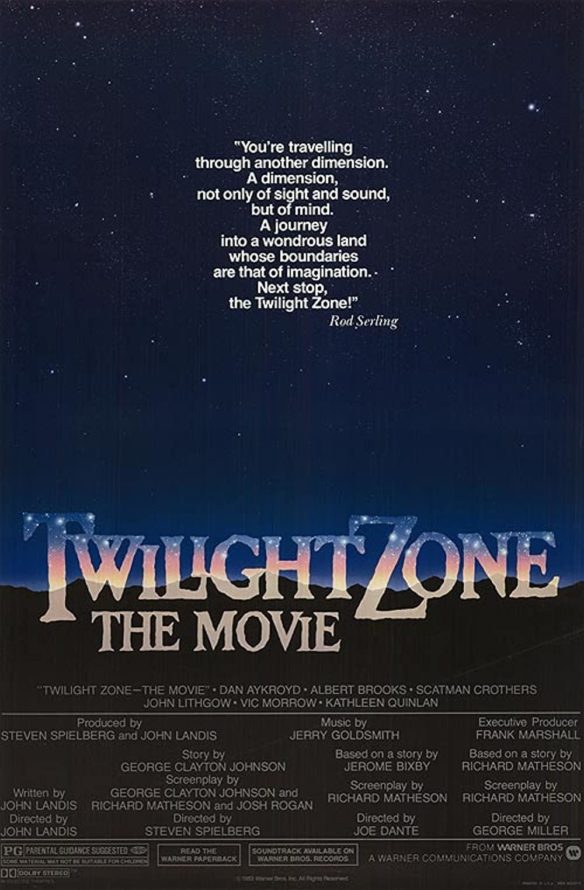
(11) TODAY’S BIRTHDAYS.
[Compiled by Cat Eldridge.]
(12) COMICS SECTION.
(13) DEADLY DESIGNS. Paul Weimer will make you want to read the second City Siege novel of KJ Parker: “Book Review: How to Rule an Empire and Get Away with it” at Nerds of a Feather.
…While the first volume had Orban explicitly say that he was not telling the whole truth in the end, here from the beginning we have a professional telling us right from the get go about the power of stories, lies, shading the truth and more in order to tell his story. The first novel was Parker geeking out about engineering and siegecraft and how a determined engineer could frustrate the greatest army the world has assembled. By contrast, this second novel does have concerns regarding the siege and defending it, because Parker does really like to go down his rabbit holes and show it off. (In some ways, I think of him very much like Herman Melville, just enjoying sharing what he has learned and shown off about all sorts of abstruse subjects, interwoven masterfully into the story)….

(14) OCTOTHORPE. With a cover courtesy of DALL-E, Octothorpe 60 is now up! Listen here: “Different Types of Tedium”.
John Coxon is going to brunch, Alison Scott watched a film, and Liz Batty is critical. We discuss what we’d do if we were king of The Hugo Awards for the day, and then we talk about ABBA and other science fiction. And Monster Munch – you love to hear it.

(15) LIGHT FINGERS. Yahoo! listens as “Taika Waititi admits to stealing equipment from ‘The Hobbit’ set”.
New Zealand filmmaker and actor Taika Waititi appeared Wednesday on The Late Show With Stephen Colbert, where he shared a Hobbit-sized secret regarding the second film in the popular franchise directed by fellow Kiwi Oscar winner Peter Jackson.
Waititi shared, “When I did What We Do in the Shadows, when Jemaine [Clement, the film’s co-writer and star] and I were shooting that, we didn’t have much money to do that film, and The Hobbit had just wrapped. And, so, our production designer — man, I don’t know if I should tell this. OK, but I will. Our production designer, in the dead of night, took his crew to The Hobbit studios and stole all of the dismantled, broken-down green screens and took all of the timber, and we built a house.”…
(16) THEY CROSSED THE STREAMS. “The Mandalorian gets mashed up with The Stay Puft Marshmallow Man in Star Wars/Ghostbusters crossover cosplay” at Ghostbusters News. They draw our attention not only to the clever cosplay, but “the adorable replacement for Grogu, consisting of a miniature version of Stay Puft being seen nestled inside his pram pod.”
(17) IT IS HIS FETA. Gizmodo takes a pretty funny look at “The Weirdest, Goat-iest Thor: Love and Thunder Merchandise”.
Marvel’s latest movie is bringing with it an Asgard Tours boat-load of weird and wonderful merchandise.
(18) REVISITING FILMATION. [Item by Bill.] The 1973-1974 Star Trek: The Animated Series was produced by Filmation. Recently, Gazelle Animations has done some clips from Star Trek: The Next Generation and Star Trek: Voyager in the Filmation style:
The animator gives background. And note the Most Important Device in the Universe!
(19) VIDEO OF THE DAY. [Item by Martin Morse Wooster.] In “Lightyear Pitch Meeting,” Ryan George, in a spoiler-packed episode, the producer learns that the premise of Lightyear–that it’s an action movie Andy saw in 1995 that made him want to buy a Buzz Lightyear toy–he gets excited because that means a producer in the Toy Story universe made money on the film. But even though it’s supposed to be “a 1990s movie,” fans of 1990s movies that featured “a lot of over the top action and cheese” will be cruelly disappointed. Toy Story fans who remember that the villain Zurg is Buzz Lightyear’s father will also be very disappointed.
[Thanks to Andrew Porter, Michael Toman, Cat Eldridge, N., Bill, SF Concatenation’s Jonathan Cowie, Daniel Dern, Mike Kennedy, Martin Morse Wooster, JJ, John King Tarpinian, and Chris Barkley for some of these stories. Title credit belongs to File 770 contributing editor of the day Steve Davidson.]
(1) HARASSMENT CAMPAIGN. [Item by Meredith.] Someone(s) used the names and email addresses of several members of sf/f fandom including Paul Weimer, Patrick S Tomlinson, John Scalzi, and Adam Rakunas to send racist abuse to a black author (@fairyfemmes) through the contact form on their websites (where the email address can be entered manually). The author originally believed it was real, but is now wanting to know who is behind it. They’ve taken their account private.
John Scalzi tweeted:
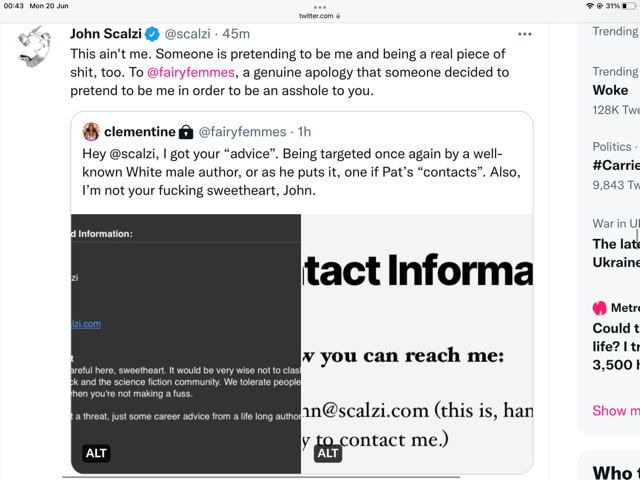
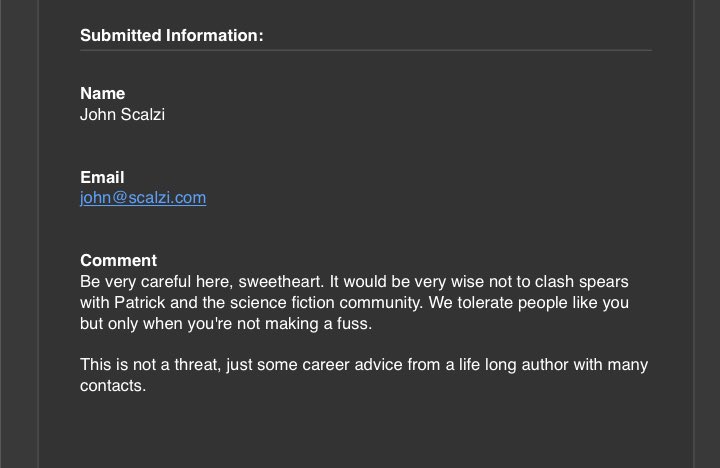
Paul Weimer posted on Patreon about “The Trolls Harassing others in my name”.
The Trolls that have harassed me for years in my name have come up with a new and horrible trick–they are harassing others, in this case, a POC, and using my name to do it.
So it’s a double whammy–to hurt someone else, and to blacken my name at the same time.
Patrick S. Tomlinson addressed a message sent under his name, and another from the person posing as Adam Rakunas.

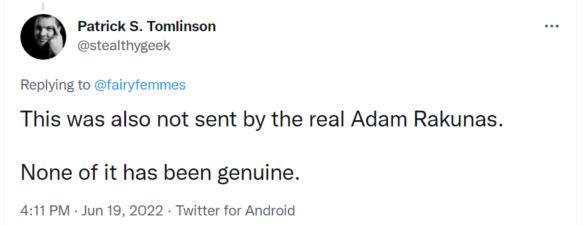
(2) TONOPAH PROGRAM UPDATED. The most recent (June 19) Westercon 74 Program Schedule version has downloadable PDFs of the Program Grid, which shows items by date/time/location. Click on the link.
(3) WISCON’S COVID OUTCOME. The “WisCon 2022 Post-Con COVID-19 Report” begins with a fully detailed account of the extensive COVID-19 safety measures instituted by the committee, then assesses the results.
…Two weeks out from the end of the convention, we are stopping our case tracking efforts. While it’s impossible to say with any certainty whether some members arrived sick, contracted COVID-19 during travel to/from, or contracted COVID-19 at the con, we can, with much gratitude, report that we had a total reported count of 13 cases including one possible false positive, or 3% of our estimated 407 in-person attendance. That’s just about miraculous.
We want to especially extend our thanks to those who tested positive very soon after arriving and took the necessary measures to take care of themselves and keep those around them safe, up to and including leaving the convention entirely. We know it must have been so gut-wrenching and disappointing. Thank you….
(4) STOP DISCOUNTING CRAFTSMANSHIP. Mark Lawrence reacts to a viral tweet by someone who rates books highly for other things than good writing in “I don’t care how good a writer you are…”
…It’s as if people are celebrating the idea that writing doesn’t matter and that “good writing” is some form of intellectual elitism that doesn’t have anything to do with them. They’re death metal fans and they don’t care about opera.
But that is, of course, nonsense. It’s akin to saying “I don’t care how good a brain surgeon you are, as long as you get this tumour out.” “I don’t care how good a mechanic you are, as long as you fix my car.” Sure, the end is the thing that’s important to you … but the end is generally strongly correlated with the means….
(5) SCARE PALS. Adrienne Celt advises New York Times Magazine readers that “You Need a Horror Movie Friend for a More Frightening, Less Lonely Life”.
… A lot of people hate horror movies, but I don’t. In fact, I frequently find myself strong-arming my friends and loved ones into watching something scarier than they would prefer, just for the company. It’s a difference of philosophy as much as a difference in taste. Horror deniers often claim there’s nothing emotionally valuable in the experience of being frightened. I disagree. When I first watched “The Last Unicorn” (a horror movie masquerading as a children’s cartoon) at age 8, the image of a naked harpy devouring a witch was burned into my brain, but so was the realization that the conditions that created the harpy also allowed for the unicorn. The existence of horror is inevitably proximate to the existence of wondrous possibility.
Meeting another person who loves horror as much as I do, then, is like meeting a fellow traveler from my home country while stuck somewhere distant and strange….
(6) A LOT TO LIKE. Rich Horton continues his project of filling in the historic blank spaces with “Hugo Nomination Recommendations, 1954” at Strange at Ecbatan.
… This was a remarkable year for SF novels, and the five that I list as nominees — the same list the Retro Hugo nominators picked — are all certified classics in the field. There some impressive alternate choices too — among those I list, Leiber’s The Sinful Ones (an expansion and in my opinion an improvement on his 1950 short novel “You’re All Alone”) is a personal favorite. In my Locus article I picked The Caves of Steel as the winner, but I’m really torn. Nowadays I might lean to either More Than Human, or to the Retro Hugo winner, Fahrenheit 451….
(7) REREADING PRATCHETT. Nicholas Whyte discusses “Mort, by Terry Pratchett” at From the Heart of Europe.
…You’ve read it too, so I won’t go on at length. It is as funny as I remembered. I was pleasantly surprised on re-reading by the breadth and depth of references to classic (and Classical) literature. The main driver of the Sto Lat subplot, the rewriting of history and destiny, is actually more of a science fiction trope, rarely found in fantasy (and the description of it is fairly sfnal). And Death’s slogan resonates still for me, 35 years on.
THERE’S NO JUSTICE. THERE’S JUST ME.
(8) A VISION FOR SF. Pop quiz: What editor’s name immediately comes to your mind when you read the statement that Astounding shaped modern science fiction? My guess is it won’t be the name that came to Colin Marshall’s mind when he wrote this post for Open Culture: “Revisit Vintage Issues of Astounding Stories, the 1930s Magazine that Gave Rise to Science Fiction as We Know It”.
Having been putting out issues for 92 years now, Analog Science Fiction and Fact stands as the longest continuously published magazine of its genre. It also lays claim to having developed or at least popularized that genre in the form we know it today. When it originally launched in December of 1929, it did so under the much more whiz-bang title of Astounding Stories of Super-Science. But only three years later, after a change of ownership and the installation as editor of F. Orlin Tremaine, did the magazine begin publishing work by writers remembered today as the defining minds of science fiction….
(9) HAPPY 90TH. [Item by Martin Morse Wooster.] In the Washington Post, classical music critic Michael Andor Brodeur celebrates John Williams’s 90th birthday with recommendations about his orchestral music to try (ever heard his flute concerto or his violin concerti?) “Composer John Williams being feted with performances at Kennedy Center”.
… For “John Williams: A 90th Birthday Gala,” conductor Stéphane Denève will lead the NSO in a sprawling celebration of Willams’s famed film music. Special guests cellist Yo-Yo Ma, filmmaker Steven Spielberg and German violinist Anne-Sophie Mutter will cue up selections from some of Williams’s most beloved scores, including “Close Encounters,” “E.T.,” “Harry Potter,” “Indiana Jones” and “Schindler’s List.” The program will also highlight Williams’s most recently lauded work, the score to Kobe Bryant and Glen Keane’s Oscar-winning 2017 short film “Dear Basketball.”
A pair of companion concerts flanking the gala celebration will focus on two of Williams’s best-known scores — representing a fraction of his 29 collaborations with Spielberg. (Their latest project, “The Fabelmans,” is due out in November). Steven Reineke will conduct the composer’s scores for “E.T.” and “Jurassic Park” on June 22 and 24, respectively. (The NSO will also perform Williams’s score for “Star Wars: The Empire Strikes Back” with a screening of the film at Wolf Trap’s Filene Center on July 29.)
Taken together, the birthday party is three days of music that will hit all the subconscious buttons that Williams has wired into our collective memories over the past five decades — a rich catalogue of instantly identifiable melodies, moods and motifs that can conjure entire worlds with the stroke of a bow.
The party, however, conspicuously forgot to invite Williams’s concert music — the province of his output that truly opened my ears to his compositional mastery. (It also leaves out selections from “A.I. Artificial Intelligence,” a deep cut that represents some of his best work with Spielberg, but that’s another story.)
I get it. We have come to equate Williams with Hollywood so closely that it can be hard to fathom him freed of cinema’s frame.
But in Williams’s many concertos, chamber works and solo pieces, his familiar compositional voice is fully present, albeit put to completely different use. His connections to multiple classical traditions register more clearly: his Berg-ian penchant for darkness and dissonance, his Copland-esque ease with evoking natural grandeur, his inheritance of gestures from Debussy, Wagner, Tchaikovsky and Korngold.
Here are some of my favorite Williams works that have nothing to do with the movies — and have a lot more depth than you might expect from a composer we associate with the silver screen….
One of the pieces Michael Andor Brodeur recommended of John Williams was his “Fanfare For Fenway” so here it is as Williams and the Boston Pops perform the world premiere at Fenway Park in 2012.
(10) THINK FAST. Deadline calls it “Zaslav’s First Movie Crisis: What To Do With Ezra Miller, The Erratic Star Of Warner Bros’ $200M ‘Flash’ Franchise Launch”
Even though it isn’t on the Warner Bros release calendar until June 23, 2023, The Flash is becoming Warner Bros Discovery CEO David Zaslav’s first movie crisis, because of the escalating coverage of incidents of volatile and odd behavior involving the film’s star, Ezra Miller.
Zaslav has made clear his desire to grow the DC Universe to MCU scale and has all the ingredients of a first foot forward in The Flash, including the return of Michael Keaton as Batman along with a reprise by Ben Affleck, a $200 million budget and a hot director in Andy Muschietti, who delivered the blockbuster It for the studio. The Warner Bros Discovery CEO exercised his well known penchant for micro-management by declining to greenlight Wonder Twins for being too niche. Zaslav will have to soon make a decision of what to do with the completed picture that is The Flash, and what to do with a young actor who appears to have serious off-set issues….
(11) VERTLIEB MEDICAL NEWS. Steve Vertlieb is home after his fifth hospital stay of the year. He brings everyone up-to-date in “Back To The Suture 3” on Facebook.
… Days upon days of antibiotic treatment were required before they dared to open the wound and clean out the bacteria. This additional procedure was accomplished on Monday, June 13th.
Consequently, I was admitted yet again to the cardiac unit where I remained for nine days more until my delayed and eventual release this afternoon. I’ve a “Wound V.A.C.” attached to my groin where it hangs rather uncomfortably, and shall continue to do so for, perhaps, the next week or two. I’m home once more, and praying that this is where I shall be permitted at long last to remain….
(12) MEDIA BIRTHDAY.
1956 – [By Cat Eldridge.] Forbidden Planet debuted sixty years ago on this date in the United Kingdom. I had the extremely good fortune of seeing Forbidden Planet at one of those boutique cinema houses some four decades back. Great sound and print, and a respectful audience who were there to see the film so everyone paid attention to it.
It was produced by Nicholas Nayfack who had no genre background and who would die of a heart attack, age forty-nine just two years later. It was directed by Fred Wilcox, best known for Lassie, Come Home. The script was written by Cyril Hume who had prior to this written scripts for two Tarzan films. It is said that is based off “The Tempest” as conceived in a story by Irving Block and Allen Adler. Huh.
I’ll skip the cast other than Robbie the Robot. He cost at least one hundred and twenty-five thousand dollars to produce, and was based off the design originating with ideas and sketches by production designer Arnold “Buddy” Gillespie, art director Arthur Lonergan, and writer Irving Block. Robbie was operated (uncredited at the time) by stuntmen Frankie Darro and Frankie Carpenter, both rather short actors. And his voice in the film was done in post-production by actor Marvin Miller.
The budget was about two million of which it was later estimated that Robbie was actually well over ten percent of that because of the cost of Miller’s time which added considerably to his cost. It made two point eight million, so yes it lost money.
So what did the critics think? Variety thought it had “Imaginative gadgets galore, plus plenty of suspense and thrills, make the production a top offering in the space travel category” while the Los Angeles Times thought it was “more than another science-fiction movie, with the emphasis on fiction; it is a genuinely thought-through concept of the future, and the production MGM has bestowed on it gives new breadth and dimension to that time-worn phrase, ‘out of this world.’”
It has a most stellar eighty-five percent rating among audience reviewers at Rotten Tomatoes.
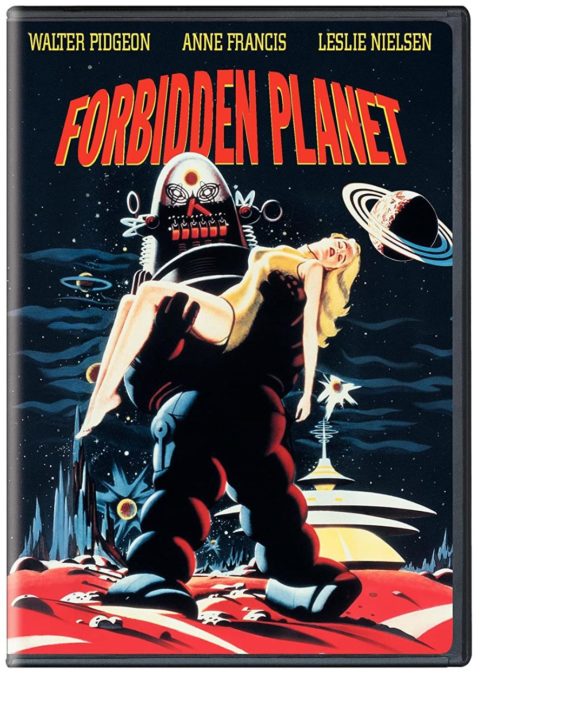
(13) TODAY’S BIRTHDAYS.
[Compiled by Cat Eldridge.]
(14) COMICS SECTION.
(15) OVERCOMER. [Item by Steven French.] Interesting interview with Sarah Hall, author of plague novel Burntcoat (not sure writing a book during the pandemic is quite comparable to what Sarah Connor did but ok …) “Sarah Hall: ‘I used to almost fear opening a book’”.
When did you begin writing Burntcoat?
On the first day of the first lockdown in March 2020, with notebooks and a pen, which I’d not done since my first novel, 20 years ago. It felt like a response to what was going on – this odd scribbling in the smallest room in the house, really early in the morning when it was quiet and eerie.And you kept it up even while home schooling your daughter?
There was some part of me that thought: “This is just one more thing that’s going to make it difficult to work and I’m going to do it anyway.” I was anxious, but I’m a single parent and I go into, as I call it, Sarah Connor mode from The Terminator: it’s out there, here’s my child, what do I need to do? Get buff! I got pains in my hand because I wasn’t used to writing so much.
(16) WACKY WIKI. If for any reason you were wondering whether Vox Day’s Infogalactic is still around, Camestos Felapton permitted his eyeballs to be stabbed with its content in order to research this post: “Incredibly, Voxopedia is still running”.
(17) THE CENTER WILL NOT HOLD. [Item by Martin Morse Wooster.] In the Washington Post, A.A. Dowd celebrates the 40th anniversary of E.T., saying the film “has the simplicity of a fable and the texture of ordinary American life.” “’E.T.,’ 40 years later, is still the most soulful of box-office sensations”.
… Not that the movie subscribes to the idea of adolescence as a carefree, unburdened time. By now, it’s conventional wisdom that “E.T.” grew out of Spielberg’s memories of his emotionally fraught teenage years. The director modeled his title character on a real imaginary friend he came up with to cope with his parents’ divorce. As written by Melissa Mathison, who combined elements from two scrapped Spielberg projects, the film became a melancholy fantasy deeply haunted by parental absence. At heart, it’s about a broken nuclear family trying to piece itself back together….
(18) WHO NEEDS SPECIAL EFFECTS? Gizmodo is delighted that “Doctor Strange 2 Gets a Dance-Heavy Blooper Reel Before Disney+ Drop”.
… Beyond that, it’s funny to watch the cast’s long capes and skirts get stuck in the scenery and have them try to fight off errant leaves as they wave their arms around doing pretend magic.
(19) A COMMERCIAL MESSAGE FROM OUR FUTURE ROBOT OVERLORDS. [Item by Mike Kennedy.] Estonian company Milrem Robotics has joined with a partner company (who supplied the 30 mm autocanon) to demonstrate what their “Type-X“ armored, uncrewed, AI-powered Robotic Combat Vehicle could do if outfitted as a tank. “Robot Tank Firing at Cars and Other Targets Is the Stuff of Nightmares” at Autoevolution.
The disastrous use of tanks by the Russians in Ukraine isn’t stopping defense contractors from researching such platforms, though. Of course, even if they look like traditional tanks, these new machines are as modern as they get.
Take the so-called Type-X Robotic Combat Vehicle, developed over in Europe by Milrem Robotics and Kongsberg Defence & Aerospace. That would be an autonomous, AI-governed, tracked vehicle that could become a common presence on the battlefields of tomorrow….
[Thanks to Martin Morse Wooster, JJ, John King Tarpinian, Chris Barkley, Meredith, Lise Andreasen, Steven French, Andrew Porter, Michael Toman, Cat Eldridge, and Mike Kennedy for some of these stories. Title credit belongs to File 770 contributing editor of the day Jayn.]
(1) BLUE PLAQUE SPECIAL. Radio Times reports “Verity Lambert, Doctor Who’s original producer, honoured with blue plaque”.
Some major names in the history of British television gathered on Sunday 29th May to honour the pioneering producer Verity Lambert, as Doctor Who’s very first director Waris Hussein and former showrunner Steven Moffat jointly unveiled a blue plaque on the wall of Riverside Studios in Hammersmith.
As the first ever female producer in the BBC drama department, Verity made a name for herself launching Doctor Who in 1963. Across a long and prestigious career, she produced dozens of successful and fondly remembered programmes, such as Take Three Girls, Budgie, The Naked Civil Servant, Rock Follies, Edward and Mrs Simson, The Flame Trees of Thika, Minder and Jonathan Creek. She died in 2007.

(2) KGB. Fantastic Fiction at KGB reading series hosts Ellen Datlow and Matthew Kressel present Karen Heuler and Sam. J. Miller in person at the KGB Bar on Wednesday, June 15 at 7:00 p.m. Eastern. Masks Strongly Encouraged.
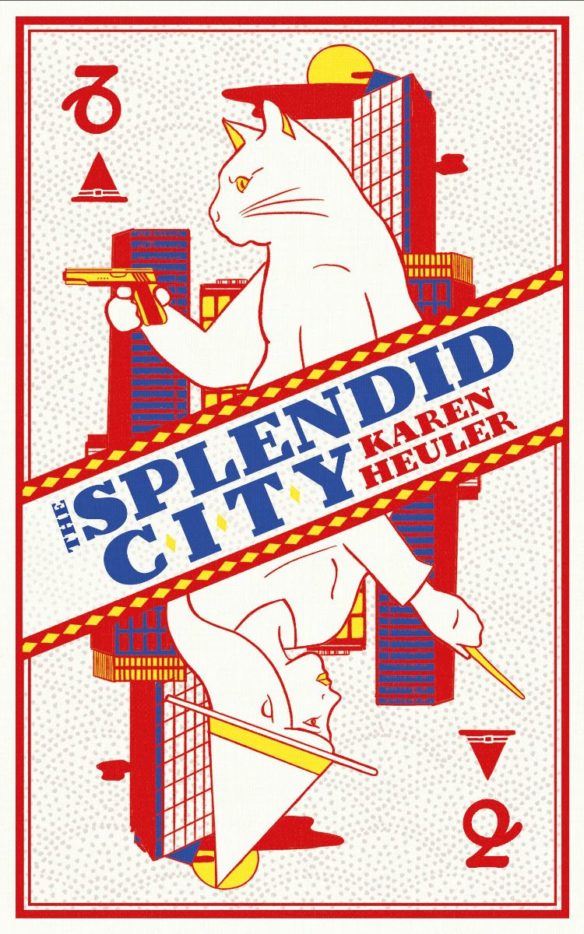
Karen Heuler’s stories have appeared in over 120 literary and speculative magazines and anthologies, from Conjunctions to The Magazine of Fantasy and Science Fiction to Weird Tales, as well as in a number of Best Of anthologies (and in one of Ellen Datlow’s anthologies!). Her latest novel, The Splendid City, has just been published by Angry Robot Books. It’s a tale about stolen water, an exiled witch and her gun-wielding cat, and a city run by a self-declared President who loves parades. She has a literary short-story collection about dementia coming out in August, and Fairwood Books will publish A Slice of the Dark, a SF/F mix, this coming November.

Sam J. Miller’s books have been called “must reads” and “bests of the year” by USA Today, Entertainment Weekly, NPR, and O: The Oprah Magazine, among others. He is the Nebula-Award-winning author of Blackfish City, which has been translated into six languages and won the John W. Campbell Memorial Award. Sam’s short stories have been nominated for the World Fantasy, Theodore Sturgeon, and Locus Awards, and reprinted in dozens of anthologies. He’s also the last in a long line of butchers. He lives in New York City, and at samjmiller.com
KGB Bar, 85 East 4th Street, New York, NY 10003 (Just off 2nd Ave, upstairs).
(3) PAUL WEIMER. Camestros Felapton continues his series of why-you-should-vote-for each Best Fan Writer finalist with “Paul Weimer: Hugo 2022 Fanwriter Finalist”.
Paul Weimer is a fan, a photographer, a podcaster, a review, a critic, a traveller and did I mention that he is a fan? A prolific reviewer and a frequent guest on numerous podcasts, Paul does not literally know everybody in science fiction but I like to imagine that he does. These days you are most likely to find paul at the Nerds of a Feather fanzine blog or on the Skiffy and Fanty podcast or among the webpages of Tor.com….
(4) HOW THE WEST WAS WON. Clarion West invites everyone to support the students coming to this year’s workshop by chipping in to pay for things on their Summer Workshop Wish List.
If you’d like to help the workshop’s students be more comfortable in our new facilities where they’ll be eating, sleeping, and living story for six weeks this summer, there are ways for you to help!
The Summer Workshop needs items large and small for the students every year—from coffee to whiteboards and beyond. This year we especially need additional safety supplies to be as safe as we possibly can during the pandemic and to meet our COVID protocols. If you’d like to help out, you can purchase items from our Amazon Wish List.
Thank you so much for helping support our students and our workshop!
(5) DEVOLVER NEWS. [Item by Martin Morse Wooster.] In the Financial Times behind a paywall, Tom Faber reviews the games of “tastemaking indie publisher Devolver Digital.” WASD was a game fair held recently in London.
Every year, a few Devolver titles inevitably make their way to year-end best-of lists. ‘That success gives us the mandate to take risks and do some really interesting, off-the-wall games,’ says Graeme Struthers, head of publishing. At WASD, this reputation attracted a constant stream of excited gamers to their booth of playable demos. I sampled new releases Trek To Yomi, a moody samurai game in grainy monochrome inspired by classic Kurosawa films; Card Shark, a beautifully illustrated tale of cheating your way to the top of 18th-century French society using only a deck of cards; and Terra Nil, a ‘reverse city builder’ that asks you not to pave over the wilderness with motorways but instead restore the countryside to its former glory…
….Many of Devolver’s best releases take a received idea about games on their head and encourage players to look at the medium from a new perspective. Often this means casting the player as a character they never thought they would inhabit. In Ape Out, you play an escaped gorilla whose every movement triggers a crash of cymbals or a snare-hit, creating a jazz score as you go. The highlight of Devolver’s upcoming roster at WASD, Cult Of The Lamb, casts players as a sacrificial lamb which escapes from the altar and starts building its own cult in revenge.
(6) SIDE BY SIDE BY CYBERMEN. Radio Times tries to read the tealeaves of the Doctor Who multiverse: “Could Yasmin Finney’s new Rose be the key to Doctor Who’s own multiverse?”
… Jodie Whittaker’s exit coming a year ahead of Doctor Who’s 60th anniversary means fans are expecting something massive in the next 12 months. Alongside the high-profile returns of David Tennant and Catherine Tate as the Tenth Doctor and Donna Noble, Heartstopper’s Yasmin Finney is paving the way for diversity. Details about these returns and debuts are sketchy, but Finney’s role as “New Rose” could have us opening the doors to the multiverse….
… When Whittaker’s Thirteen escaped a possible-future version of a nuclear-ravaged Earth in Orphan 55, she told us. “The future is not fixed, it depends on billions of decisions and actions, and people stepping up.” This was teased years earlier when the Doctor-lite Turn Left explained how drastically things can change with a simple decision. Ten’s iconic episode featured Donna being manipulated by a Time Beetle, and although ‘Donna’s World’ was erased from existence, it’s got us thinking about how many others there are.
Doctor Who has long established that N-Space is the Prime Universe in canon, but over the past 60 years, we’ve learned about a lot more. Across various media, the Doctor has visited an alternate Earth populated by the vampire-like Haemovores, the many alternate realities that have been conquered by Cybermen, and even one with Tardis Tails – an anthropomorphic cat version of the Doctor….
(7) MEMORY LANE.
1969 – [By Cat Eldridge.] On this date in 1969, the first incarnation of Star Trek came to an end. Its “five-year mission: to explore strange new worlds, to seek out new life and new civilizations, to boldly go where no man has gone before” would last just three years and seventy-nine episodes before ending with the “Turnabout Intruder”.
The ratings for the series were never great and NBC responded by cutting the production each season from one ninety thousand the first season to the one eighty-five thousand the second season to the one hundred seventy-five thousand the last season. Assuming that there were salary increases which there were obviously were, this left little for special effects, costumes or anything else by the third season. And yes, it showed.
It might have been a ratings failure in its first run but it thrived in syndication and spawned a vast franchise currently of ten television series (eleven if you include Short Treks which is remarkably good) with the latest being Strange New Worlds which I like quite a lot, and thirteen films. Not to mention novels, comics, action figures, games and toys. And decades of cosplayers.
I’ve rewatched a lot of the series recently courtesy of Paramount + which is the home of it and everything else Trek. Some of the episodes are quite excellent, some are not bad and some are really execrable. I think it holds up fairly well all things considered.
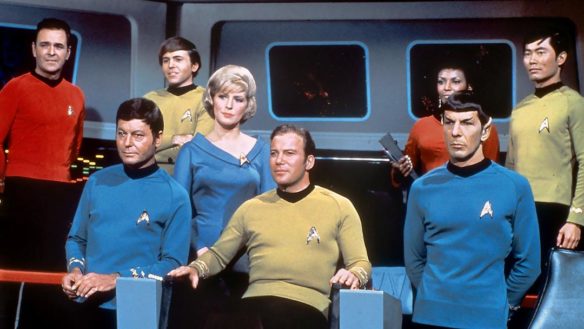
(8) TODAY’S BIRTHDAYS.
[Compiled by Cat Eldridge.]
(9) COMICS SECTION.
(10) TANGLED WEB. BBC’s Tanya Beckett takes a closer look at how China’s increasing influence is affecting the movie-making process in Hollywood. “Why did China ban Spider-Man?” – listen in at BBC Sounds.
Ever since Hollywood entered the Chinese market in the early ’90s, the importance of Chinese audiences was apparent. Over recent years the Chinese market has grown in significance to the point of deciding whether a film is ultimately successful or not. Given the country’s importance to the overall profitability of Tinsel Town, it is of little surprise that their censors are able to increasingly demand changes to films that threaten the Chinese narrative. Despite this, the recent Sony/Marvel blockbuster Spider-Man did not appear to challenge Chinese values.
(11) PROJECTING. GameSpot calls these “The Very Best Sci-Fi Movies Of the 1980s”. Twenty films – but there are three I’ve never had a desire to see. Does it help balance things that I have watched this one so many times?
2. Ghostbusters (1984)
Much like another entry on this list, Back to the Future, Ghostbusters was almost a very different film with a very different cast. Luckily, though, the production ended up with the right team and script to truly capture a lightning ghost in a bottle. Ghostbusters tells the story of a trio of academics and inventors studying the paranormal, who go into the business of capturing and containing dangerous ghosts. It is, in essence, blue-collar sci-fi, with a heavy dose of comedy resulting from having three of the best comedy actors of the 1980s on the cast. Few movies are this rewatchable and this quotable.
(12) SPEAKING OUT. In the Washington Post, Michael Cavna profiles Kristen Schaal, who is proud of her extensive voice work in animation (most recently in The Bob’s Burgers Movie) but also in BoJack Horseman and Toy Story. “Kristen Schaal of ‘Bob’s Burgers’ is the queen of quirky voice acting”.
… The Emmy-nominated actress aims to elude being pigeonholed, yet she’s well-aware that some casting directors now refer to a “Kristen Schaal type,” saying on Marc Maron’s podcast several years ago that their elevator-quick description of her as performer might well be: “She’s manic and a little crazy, coming out of that sweet face and voice.”
Whatever the alchemy within her artistry, there’s no doubting that Schaal has carved out an animation niche within her larger résumé: She is the queen of voicing the askew….
(13) AUTHOR’S PAPERS. This processing of Lawrence Watt-Evans’s papers reportedly is very recent. UMBC is the University of Maryland (Baltimore County). “Lawrence Watt-Evans papers”. They were donated in 2017.
Abstract: The collection contains materials that cover Lawrence Watt-Evans professional career from 1974 to 2018. Included are manuscripts of his books, short stories, editorials, and comics and graphic novels; personal papers; correspondence with publishers, fellow authors, and fans; and convention memorabilia including programs and fliers.
Citation: Lawrence Watt-Evans papers, Collection 260, Special Collections, University of Maryland, Baltimore County (Baltimore, MD).
(14) PIZZA NIGHT ON THE ISS. Six of seven Expedition 67 crew members are pictured enjoying pizza during dinner time aboard the International Space Station. Clockwise from left are, Flight Engineer Denis Matveev, Commander Oleg Artemyev, and Flight Engineer Sergey Korsakov, all from Roscosmos; NASA Flight Engineers Kjell Lindgren and Jessica Watkins; and ESA (European Space Agency) Flight Engineer Samantha Cristoforetti.

(15) WHERE TO GET BUTTERSCOTCH BEER. [Item by Andrew Porter.] Wand sold separately (and batteries not included!) “Flying Cauldron Butterscotch (non alcoholic) Beer – 12 Oz”.

The Art Of Magic Is Thirsty Work!
Flying Cauldron Butterscotch Beer (non-alcoholic)
Last time around, you cleared our shelves of this irresistible soda within hours of our owls delivering the newsletter!
Flying Cauldron Butterscotch (non-alcoholic) Beer is another butterscotch flavored soda in our beverage lineup. This is a fun, magical drink that is free of preservatives, free of caffeine, free of gluten & GMO’s. Enjoy this drink in a frozen mug or drop in a scoop of vanilla ice cream.
(16) VIDEO OF THE DAY. [Item by Martin Morse Wooster.] In The Mandrake, jointly made by 11 students at the Savannah College of Art and Design, carrot farmer Mr. Rabbit is right to worry when a raccoon shows up with a strange plan.
[Thanks to Martin Morse Wooster, JJ, John King Tarpinian, Chris Barkley, Nancy Sauer, Andrew Porter, Michael Toman, Cat Eldridge, and Mike Kennedy for some of these stories. Title credit belongs to File 770 contributing editor of the day Peer.]
(1) NOBEL MEDAL AUCTION. Heritage Auctions is taking bids for the “Dmitry Muratov 2021 Nobel Peace Prize Medal”, being sold to benefit children and their families forced to flee Ukraine and those internally displaced since the start of the war in February. All proceeds will support UNICEF’s humanitarian response for children in Ukraine and neighboring countries.
Dmitry Muratov is the editor-in-chief of the influential Russian news outlet Novaya Gazeta. Bidding will conclude with a live auction at The Times Center in Manhattan on World Refugee Day, June 20.
“The editors of Novaya Gazeta decided it was necessary to help those in desperate need,” says Muratov, who in 1993 co-founded the Moscow-based publication that is now the last independent newspaper in Russia. “Everyone understood that we had to help, and the sale of the Nobel medal through Heritage Auctions gave us a powerful opportunity to help Ukrainian refugees. We hope that everyone around the world supports us and contributes to this movement, however they can.”
Muratov shared the 2021 Nobel Peace Prize with Filipino journalist Maria Ressa. The Norwegian Nobel Committee celebrated their “fight for freedom of expression in a world in which democracy and freedom of the press face increasingly adverse conditions.”
(2) ORIGINS AWARDS HELD OVER TO 2023. The Game Manufacturers Assocation (GAMA) told Facebook readers:
We are not having the Origins Award this year. We will be bringing them back for 2023 and will have information this fall on categories and submission process.
The awards also were not given in 2021, which prompted this comment from Jason Williams:
Can I ask then what happened to all the physical games which were entered as the awards were open for entry in 2021,(this is for game titles produced in 2020) and publishers did invest time and resources on making entries. Maybe those games which were entered need to have awards in 2023 recognized if there are enough staff available then. The fact that in 2021, submissions were accepted, but no awards were ever given, seems pretty wrong. Especially since titles are only able to be entered for the awards in the year they are published and these titles can never be considered for these awards in the future.
GAMA did not reply.
(3) JASON SANFORD. Camestros Felapton continues his series of why-you-should-vote-for each Best Fan Writer finalist with “Jason Sanford: Hugo 2022 Fanwriter Finalist”.
Jason Sanford is a fan journalist, reviewer and award-nominated novelist. He is having a busy year with two different streams of his work being recognised in 2022: he was a Nebula Award & Philip K Dick Award finalist for Best Novel with The Plague Birds and he is a Hugo Award Finalist for Best Fan writer.
As well as being a published fiction writer, Sanford is a prolific fan writer with an active interest in news and invents within fandom and genre publishing….
(4) NKWETI Q&A. “Nana Nkweti on Writing Cameroonian American Experiences & Crossing Genres” at Open Country.
Nana Nkweti started writing at nine years old. A sci-fi lover even then, her earliest stories saw her in future worlds, going on space adventures. Like most writers, she was a voracious reader, digging through her father’s books, the good fortune of having a home library. She read everything from fantasy to the realist classics, and began to imagine herself and girls who looked like her reflected in those stories.
It is no surprise then that the 10 stories in her collection Walking on Cowrie Shells centre Cameroonian women. The characters share her intersectional identity, as a Black woman, a hyphenated American, an ethnic African. But the stories also speak to the universal idea of people charting next steps, growing and evolving along the way.
The title “Walking on Cowrie Shells” is a play on the English idiom. She deploys it in the book to embody that sense of being in a threshold, in liminal spaces, of teetering between choices, between cultures or identities. Her characters are tentative; they are about becoming and figuring life out, who they are, who they want to be….
(5) BARRIERS TO PUBLICATION FOR AFRICAN SFF WRITERS. The If This Goes On (Don’t Panic) podcast takes up “Publishing in Africa: Publishing Platforms Or the Lack Therof with Oghenechovwe Donald Ekpeki”. The cohosts are Alan Bailey, Cat Rambo, Diane Morrison, and Graeme Barber.
In our 3rd audio column about publishing in Africa we chat with Oghenechovwe Donald Ekpeki about how Africans are being deplatformed within the publishing business. We also discuss the The Emeka Walter Dinjos Memorial Award For Disability In Speculative Fiction. As this episode was recorded before the 2022 Nebulas, we’d also like to congratulate Oghenechovwe on his award.
(6) SAULSON REPORTS ON CONVENTIONS. Sumiko Saulson reports “StokerCon 2022 was like a Black family reunion, but the struggle is far from over” at SF Bayview. Includes quotes from Craig L. Gidney, Steve Van Patten, and L.M. Wood.
…“The best part of going to cons these days is seeing the increase of diverse creators in the community. When I first started going to cons, I was one of a few folks of color. Now I’m one of many. And it feels great!
“I love that there are other Black queer creators out there – such as yourself [referring to Saulson], Kai Ashante Wilson and Marlon James. And even in that cohort, there are immense differences! For years, I wrote my fiction in isolation, collecting rejection slips like some people collect decoder rings. Now, not only is there a readership, there are other authors. It’s a great time to be publishing!” rejoiced Craig L. Gidney, author of the “Nectar of Nightmares.”
Another positive outcome for the new in-person conventions is an increase in POC representation amongst the Guests of Honor. For instance, Floyd Norman, an 86-year-old African American animator, writer, and comic book artist who was the first Black person to be a regular employee on Walt Disney’s animation staff will be the artist guest of honor at WorldCon in Chicago this year….
Saulson also covered the discussion here of SFWA’s removal of Mercedes Lackey from the Nebula Conference:
…In the wake of the incident, the power dynamics remained in play, as older, white authors have flocked to the File 770 article on the situation in defense of Mercedes Lackey, many of them citing Samuel Delaney’s personal lack of offense at the comment in their sometimes mean spirited comments about Jen Brown. Many such comments were removed from the “r/fantasy” Reddit….
Many comments weren’t approved for File 770, either, but speaking about the ones that were, including two welcome additions from Saulson, my goal for having that discussion was to let some in the File 770 commenting community who needed to do so alleviate their ignorance, while others came alongside to battle the excuse-makers and set proper boundaries for future discussion. I’ll point to what I said in that discussion:
Introducing the word shibboleth is an unwelcome attempt to ask white people to give intent priority over the clear statements from black people who take offense at the word. Even if Delany or Steve Barnes aren’t condemning Lackey, the status of the word is plain to see.
(7) TIME FOR A ROYAL FLUSH? [Item by Olav Rokne.] Various members of my book club and I have been jabbering away about monarchy in SFF at various points over the past several years. So when we realized that the vestigial monarch of England (and various former vassal states) was marking an arbitrary anniversary of a meaningless ceremony, Amanda and I decided was a good opportunity to talk about the various kings, tsars, emperors, etc. that populate so much SF. So we collaborated with some other folk in pulling this blog post together quickly this week. “The Tsars Like Dust” at the Hugo Book Club Blog.
…Given that there are few places that are still governed by monarchs of anything other than a vestigial variety, it might seem reasonable that few authors choose to engage critically with the consequences of the monarchies they depict. Americans under the age of 244 and British people with no recollection of what things were like before Peterloo don’t have any direct experience with just how truly awful it would be to live in a polity governed by Emperoxes. (Even if there’s a good ruler like Greyland once in a while, they end up being hamstrung by the weight of tradition.)
Authors seeking to more accurately depict what a space empire might look like should probably look to the few modern-day examples of absolute monarchy that still exist, places like the Sultanate of Oman, the Kingdom of Eswatini, and the Kim Family Protectorate of North Korea. To put it bluntly, in the real world there is a strong correlation between the authority of monarchs, and a lack of human rights, and this is rarely depicted in science fiction….
(8) TONOPAH NEWS. The Westercon 74 in Tonopah program schedule is now online. Strangely, it seems to be in alphabetical order by title of the program item – rather than in chronological order.
The Virtual Program schedule is in chrono order.
(9) MEDIA BIRTHDAY.
2015 – [By Cat Eldridge.] Seven years ago this evening, on what was ABC Family, the Stitchers series premiered. The premise is simple: Kirsten Clark, who has been recruited into a covert government operation is to be “stitched” with the memories of people recently deceased to investigate murders.
It was created by Jeff Schechter who as near as I can tell had little genre background other than Strange Days at Blake Holsey High and Animorphs, but I will single him out for the very non-genre series, Transporter: The Series which was off Luc Besson’s Transporter film.
Kirsten Clark was played by Emma Ishta. In addition, you’ll recognize two other cast members — Salli Richardson-Whitfield from Eureka who is Magritte “Maggie” Baptiste here and Allison Scagliotti of Warehouse 13 who is Camille Engelson in this series. The only other actor worth noting is Kyle Harris as Cameron Goodkin.
Stitchers was popular enough that it made through three seasons before getting canceled. It did not accrue a lot of episodes, being treated like a British series as each series had only only ten episodes save the first that had eleven.
So did the critics like it? No, they didn’t.
Variety’s review was typical: “About as slim as a sci-fi-inspired premise gets, ‘Stitchers’ joins a long list of series built around wide-eyed youths with an unusual skill who are recruited to join a save-the-world-type enterprise. In this case, the protagonist is a beautiful and brilliant Caltech student with temporal dysplasia, which means she doesn’t feel the passage of time. Most viewers, however, will likely feel it acutely while wading through this tired and predictable hour, which centers on a secret program that hacks into the brains of the recently deceased to solve crimes. While its heroine might not know it, skipping ‘Stitchers’ will save you time.”
Collider wasn’t any kinder: “The show’s premise thematically belongs to Syfy, and the cast is very CW, but nothing about Stitchers really comes together for ABC Family. Kirsten is described as emotionally void, and the show shares the same fate. Unfortunately, it doesn’t also happen to be brilliant to offset its other faults. The show is all over the place with its story and its tone, portraying Kirsten as a hacker, and then as a super-sleuth. Though there is some potential and humor present with its minor cast, the series pulls together elements of many other series — like CSI and Bones — without improving upon them. A missed opportunity, Stitchers is looking for signs of life, but hasn’t found them yet.”
Eighty six percent of audience members at Rotten Tomatoes liked it. Good for them.
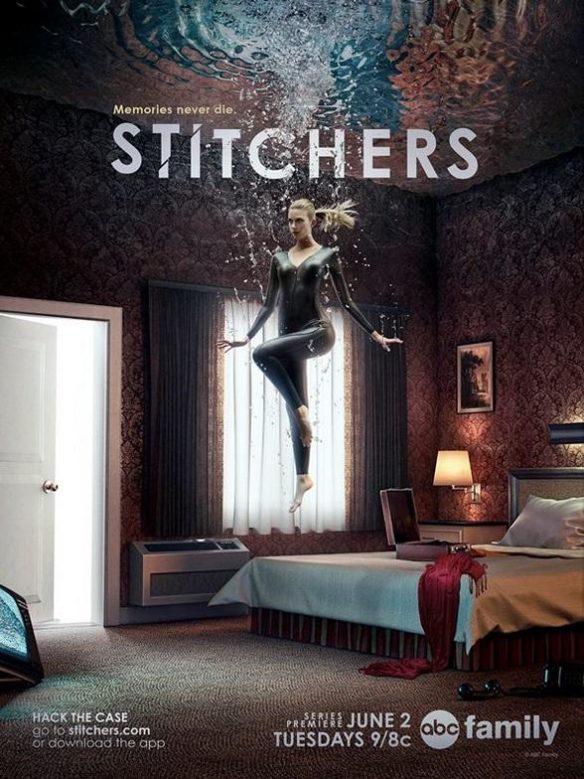
(10) TODAY’S BIRTHDAYS.
[Compiled by Cat Eldridge.]
(11) DANGER ZONE. Lawyers, Guns & Money’s Robert Farley compares Pete Mitchell (from Top Gun: Maverick) to Luke Skywalker: “Pete Mitchell and Luke Skywalker”.
… As it happens, the distance between Top Gun and Top Gun: Maverick is 36 years, while the distance between Return of the Jedi and the Last Jedi is 34 years. In both films those numbers are fully realized; Hammill and Cruise each play characters with the weight of three and a half decades on their shoulders. It is perhaps worth mentioning that the mission in Top Gun: Maverick is modeled on nothing so much as Luke Skywalker trench run against the Death Star in A New Hope. I find it awfully interesting that Pete “Maverick” Mitchell and Luke “Red Five” Skywalker each returned to the screen thirty-five years after the completion of their triumphant 80s arcs. I would not have guessed that the former would have been much more favorably received than the latter, and I think it’s worth investigating why….
(12) SFWA AUCTION RESULT. The second SFWA Silent Auction brought in nearly $18,400. Over 200 items, tuckerizations, and virtual sessions were offered. The funds will go to support SFWA’s ongoing work to promote, advance, and support SFF storytelling.
(13) UNFINISHED SYMPHONY. Paul Weimer delves into “the final, and incomplete, work by a master of science fiction and fantasy” — “Microreview [book]: Aspects by John M. Ford” at Nerds of a Feather. But first he issues a warning:
…If reading incomplete books is not your cup of tea, if the fact that this story does end abruptly without resolution, then, honestly, you probably don’t need to continue on with this book review and can go, read The Dragon Waiting or something else. I admit that it poked and prodded at my brain, but I think the book and what it does, what we have of it, is worth discussing, even in an incomplete stage. Inside baseball, perhaps, but it is akin to being shown the first chapters of a book or part of a novella from a friend writer, asking for what they think of it and what works and what does not….
(14) A NICE WAY TO SPEND 100 HOURS. Joe DelFranco is gung ho about Elden Ring: “Review [Video Game]: Elden Ring by From Software” at Nerds of a Feather.
Elden Ring is a vast, seemingly endless experience, that delivers wonders and death at every turn. A hit in all spheres of the industry, loved by fans and journalists both, not just for its generous amount of content but for its ability to transport the player firmly into the Lands Between without loosening its grip for hours on end. From Software has delivered a game that lets the player go on the adventure that they wish without holding their hand, a rarity in video games nowadays; a risk that paid off….
(15) THEY AIM TO PLEASE. The Corridor Crew wants to show you have different the series would be if Stormtroopers could hit what they shoot at: “We Made Star Wars Stormtroopers Accurate”.
Jordan and Fenner set out to correct the most glaring mistake in the original Star Wars trilogy–the lack of affordable health care for the Stormtroopers.
(16) UNLIKELY HERO RETURNS. Willow is an original series streaming on Disney+ beginning November 30.
(17) VIDEO OF THE DAY. [Item by Martin Morse Wooster.] In Harry Potter and the Order of the Phoenix Pitch Meeting,” Ryan George says when Dolores Umbridge shows up in the fifth Harry Potter movie, she’s “super-snotty and mean: because she interrupts Dumbledore’s annual speech on the many ways Hogwarts students can die. Also, the vision of Voldemort Harry conjures up is even more terrifying because Voldemort’s wearing a zip-up hoodie!”
[Thanks to Mike Kennedy, Martin Morse Wooster, JJ, John King Tarpinian, Bonnie Warford, Chris Barkley, Andrew Porter, Michael Toman, and Cat Eldridge for some of these stories. Title credit belongs to File 770 contributing editor of the day Steve Davidson.]
“To have power over a thing, name it. To name a thing, know it. To know a thing: become it.” — “Camouflage”, Patricia McKillip
By Paul Weimer: If the world of fantasy is a series of baronies, duchies, emirates, city states, and kingdoms, and every fantasy author has a place of their own in fantasy, there is a special realm. A realm of subtle magic, and of beautiful music. Where the people are a full part of the land, a rich place where its creatrix has imbued the place with immersive detail. Where bards sing and myth and legend wind into the fabric of the land, the soul of the people who inhabit it. A land of poetry and power, always wondrous to cross the border and visit.
This is the realm of Patricia McKillip.
In the mid to late 1990’s, I started a serious campaign to really understand a genre I had already been reading for 20 years: science fiction and fantasy. I had been led by chance, choice and suggestion up into that point but in the middle of the 1990’s I decided to be more systematic in my reading of SFF. Not being connected to a wider community of science fiction, I used the tools I had on hand, and leaned on my issues of Locus to tell me what I should be reading–by looking at finalists and winners of various awards. The Hugo Award, the Nebula Award, the Locus Award, and among others, the Mythopoeic Award.
And, so among the many fine authors and their work I thus started to discover in the late 1990’s in that effort would be Patricia McKillip. It seems to be a truism for me that if I really like an author’s work, no matter how much better their subsequent work is, I bond very strongly with the first work of theirs I read. This is definitely true of McKillip. When I saw in that long ago issue of Locus that she had won the Mythopoeic Award for Song for the Basilisk, I went and dutifully picked it up at Forbidden Planet. (I was blessed, living in NYC, to have a dedicated SFF bookstore I could rely on).
The lush cover reminded me a bit of Tom Canty’s work (it is actually by Kinuko Y. Craft). The lush and richly descriptive and immersive prose reminded me some of the more poetic aspects of Tolkien, or the descriptive power of early Zelazny, or Peter S Beagle. I fell for the story of Caladrius/Rook/Griffin hard and well. For all that I love sorcerers and martial heroes, having a bard as a hero was something relatively unusual in my reading. It’s a careful and well-drawn thing, a writer who knows the power of words, the power of music, the power of language and revelation, to use a character who is raised to be all of that to point and counterpoint the very techniques that the author uses to bring the story to life. And it was a revelation to have a hero deal with the villain not by a swordfight, or a magical contest, but with the power of music. And even there, the denouement is not as straightforward or direct as you might think. It’s a high wire balancing act that charmed me into her worlds, firmly and forever.
I then subsequently started reading McKillip’s work, backwards and since, from the Celtic-themed Riddle-Master books all the way to the last work of hers I read, “Camouflage”, a story in Jonathan Strahan’s The Book of Dragons, introducing us to yet another everyday character, Will Fletcher, who is better at hiding his talents even from himself than even he knows. It is a story of hope and building and working toward a future.
I find that I have not read as much of McKillip’s short fiction as I have with her novels. However, her short stories, especially the aforementioned and most accessible “Camouflage”, I feel ARE a good way for readers who might be reluctant or nervous to immerse themselves into McKillip’s work and just want to try a taste of her down-to-earth characters, her love of language, of poetry, of evocative description, of characterization and beats of the heart that draw you to love and fall in love with her characters. In an age and time where a lot of epic fantasy is frenetic, kinetic, and dark, there is a more stately and beautiful pace that McKillip’s work evokes. It is not all light and sweetness, there can be depth and darkness in her work, but her worlds are fundamentally more optimistic, and brighter, than a large share of fantasy today.
Sadly, now, McKillip and her work have come to an end. Her influence (never her shadow, she illuminated, not overshadowed her peers) runs to fantasy today, even in this age of grimdark fantasy and gritty shades of grey. Authors like Michele Sagara, Julie Czerneda, Daniel Abraham and others carry on her tradition, extending and reinventing and exploring what McKillip first illuminated, extending the boundaries of fantasy in her vein.
I will close with a quote from early in A Song for the Basilisk that just shows the sheer power of her ferocious literary talent:
“Play the song you made for the picochet. See if you can find it on the harp.”
He tried, but the sea kept getting in the way of the song, and so did the hinterlands. He gazed at the floating hills, wondering what he would see if he walked across them, alone through unfamiliar trees, crossing the sun’s path to the top of the world. Who would he meet? In what language would they speak to him? The language the sea spoke intruded then, restless, insistent, trying to tell him something: what song he heard in the seashell, what word the rock sang, late at night under the heavy pull of the full moon. His fingers moved, trying to say what he heard, as the sea flowed like blood in and out of the hollows and caves of the rock, trying to reach its innermost heart, as if it were a string that had never been played. He came close, he felt, reaching for the lowest notes on the harp. But it was his own heart he split, and out of it came fire, engulfing the rock in the sea.
Requiescat in pace, Patricia McKillip.
[This post will also appear at Green Man Review.]
(1) EMPEROR STARDUST RETURNS. For last night’s Nebula Awards ceremony Henry Lien returned in his Emperor Stardust persona and supplied a rocking musical introduction to The Andre Norton Nebula Award For Middle Grade And Young Adult Fiction category. Not an easy title to versify, and the Emperor also did a wonderful job of making the nominees into lyrics as well. He begins —
It’s the Andre Norton Nebula Award
And if you read these books you’ll totally be floored…
(For a captioned version see the official Nebula Awards Ceremony video starting around the 46:00 mark.)
(2) EVERY BOOK A WINNER. Popular fan artist Alan White will be holding a garage sale next weekend in Las Vegas. No wonder the poster is so gorgeous.
MADNESS ENSUES as 4000 paperbacks and several hundred hardbacks magically disappear for prices unknown in modern times! YOU, yes YOU can have a commanding library of dang near every possible genre author in a matter of minutes! Here’s your chance to beg out of social events by saying, “Sorry, I have books to read”. Here’s your chance to wonder “What the hell am I going to do with all these damn books?” while your mundane friends complain “Looks like a fire hazard to me”. Oh, the pity of it! This event runs all day Saturday beginning at 10AM sharp. (I plan on sleeping till 9:50am). And on Sunday until 2pm or the shelves are bare! Will this sale be an astounding success or a calamitous disaster? If you don’t show, you won’t know!

(3) STEVE VERTLIEB MEDICAL UPDATE. Steve Vertlieb was rehospitalized after developing a blood clot in one leg, and underwent surgery on May 19 to deal with it. The initial reports are favorable.
(4) IMMEDIATE ANALYSIS. Cora Buhlert is already on record with “Some Thoughts on the 2021 Nebula Award Winners – and Two SFWA Uproars”.
…The 2021 Nebula Award for Best Novelette goes to “O2 Arena” by Oghenechovwe Donald Ekpeki. This is a win which makes me very happy, because not only is it a good story, but it’s also (to my knowledge, at least) the first Nebula win for an author who lives and was born in Africa. Coincidentally, it is also the first Nebula win for Galaxy’s Edge magazine, which normally doesn’t get a whole lot of awards love….
(5) CHRIS BARKLEY’S HUGO PACKET SELECTIONS. Best Fan Writer nominee Chris Barkley has posted a collection of links on Facebook which he calls “A Sampling of The Best of So Glad You (Didn’t) Ask 2021: The 2022 Hugo Awards Packet Edition.”
I have assembled, for your reading pleasure, what I (and my editor Mike Glyer) consider the best of the columns I wrote this past year. Mind you, in re-reading them, I was tempted to rewrite some of them or insert a few more snarky comebacks to spruce them up a bit.
But …no.
My nomination as a Hugo Awards Finalist is based on these works and I offer them to you again, dear reader, unaltered and unabridged.
A link to each column that was submitted for the 2022 Hugo Awards Voter Packet will be linked below in the comments.
(6) HOW A MENTOR DISCOVERED ARISIA – AND OTHER SFF REALMS. The Horror Writers Association Mentor of the Year award recipient Michael Knost posted on Facebook the acceptance speech he really wanted to give.
I changed my Mentor of the Year Award speech during the Bram Stoker Awards ceremony at the last second as I recognized I was too emotional to deliver it. As I wanted to recognize my first mentor. I know I ugly-cry so I wanted to spare everyone. But I’d like to say what I wanted to say then, here. I apologize for the long post.
I hated school growing up. I hated education, reading, writing, and everything that went with it. I had great teachers, wonderful people, but I didn’t like school one bit. Then I met my fifth grade teacher, Mr Bill Marino.
He caught me in the hallway one day after lunch and handed me a classic science fiction novel—a yellowing mass market paperback. He must have seen the disappointment on my face and said, “I just want you to read this. There’s no tests, no book reports, etc. I just want to know what you think of the book. AND, while you are reading it, you will be exempt from all homework that the other students have to do.”…
(7) FRIENDLY DJINN PERSUASION. “George Miller reveals first trailer for ‘Three Thousand Years of Longing’” and SYFY Wire has the essence.
… Based on a story by A.S. Byatt, Three Thousand Years of Longing marks Miller’s return to fantasy filmmaking after first delving into the genre with The Witches of Eastwick 35 years ago. The film tells the story of a solitary scholar named Alithea (Tilda Swinton), who arrives in Istanbul for a conference and finds herself in the presence of a millennia-old Djinn (Idris Elba). The Djinn offers her three wishes, after which he will be granted his freedom, but of course, Alithea is an academic, and she doesn’t necessarily believe the Djinn’s gifts — leaving him to regale her with stories of his long life in an effort to convince her….
(8) MEDIA BIRTHDAY.
2008 – [By Cat Eldridge.] Fair warning: usually we avoid essaying anything that I don’t like. I got special permission to do this film. You are warned!
Just fourteen years ago, the last installment in the Indiana Jones franchise so far, Indiana Jones and The Kingdom of the Crystal Skull, premiered on this date. (The untitled fifth Indiana Jones film is a sequel to this film and our Indy will be, if he’s the same age as Harrison Ford who plays him, eighty one years of age. A fine vintage for a globe trotting whip bearing archaeologist.)
Directed by Steven Spielberg who had directed all of these, from a screenplay by David Koepp but, and this is a huge but, Jeb Stuart, Jeffrey Boam, Frank Darabont, George Lucas and Jeff Nathanson had previously attempted to write suitable screenplays and failed. Yes, consider that for a moment — the screenplay you see is one of legions done. And the one considered most filmable. God help us. We can blame! At least we know that we can curse George Lucas and Jeff Nathanson for the story we see here.
According to the publicists, it was intended to pay tribute to the SF B-movies of the Fifties. Well in my opinion it failed at that. Aliens. Crystal skulls. Nuclear explosions. Gateways to other, well, somewheres. WTF? I really think that Indy Jones is at his best old-fashioned pulp adventure, not SF. Bah humbug.
Well it cost nearly two hundred million dollars and the appeal of Harrison Ford proved irresistible as it made four times that at the box office.
And critics mostly loved it though there were some who decidedly loathed it with all their beings.
Jeff Beyer of the Chicago Daily Herald did notice how bad the story was: “Normally it’s a terrible thing if a film only gives us one good character … except when it’s Indiana Jones, with a whip at his side. A terrible story can’t totally ruin Jones. Thank God.”
Lori Hoffman of the Atlantic City Weekly in her review took note of the long break between this film and the last one: “While we can never go home again completely, ‘Indiana Jones and the Kingdom of the Crystal Skull’ reminds us of why we fell in love with Indiana Jones in the first place.”
David Denby of the New Yorker gets the last word as he sums up my feelings towards this film: “Crystal Skull isn’t bad — there are a few dazzling sequences, and a couple of good performances — but the unprecedented blend of comedy and action that made the movies so much more fun than any other adventure series is mostly gone.”
Audience reviewers at Rotten Tomatoes are as ambivalent as I am giving it just a fifty-three percent rating.
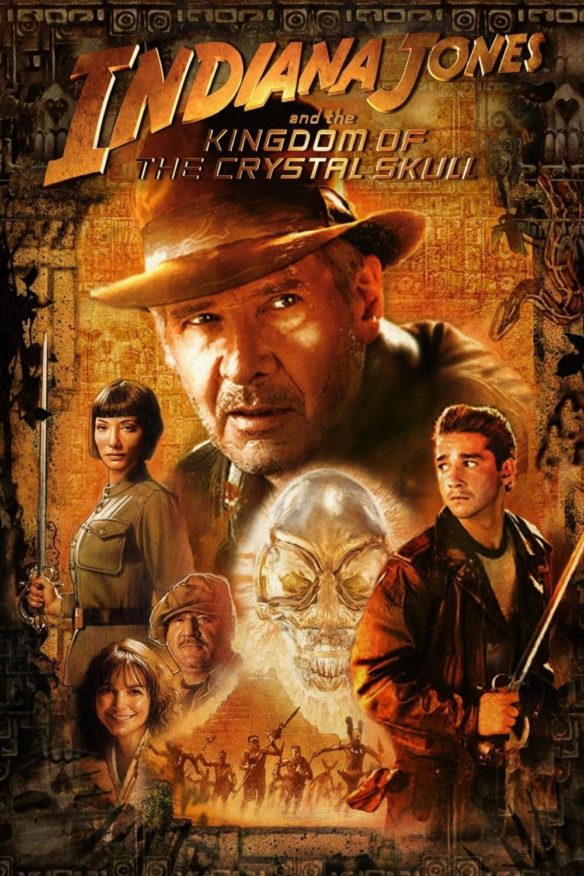
(9) TODAY’S BIRTHDAYS.
[Compiled by Cat Eldridge.]
(10) NEWS FROM NEW MEXICO. Margaret Atwood and Emily St. John Mandel are two sff writers who spoke on day one of the Santa Fe Literary Festival reports Yahoo!
…The Handmaid’s Tale author Margaret Atwood, …spoke about the leaked Supreme Court memo that suggested the US could imminently overturn Roe v Wade. She was unimpressed with justices who defend such judgments by self-identifying as Constitutional orginalists.“If you take the original Constitution [as it is and apply it], a lot of people are going to lose their rights, including all women,” she said, as well as “people who don’t own property”….
On day two, local author George RR Martin made a revelation which was reported by The Independent (registration required).
George RR Martin has revealed that when Game of Thrones, the hit HBO show based on his epic fantasy novel series A Song of Ice and Fire, was first being pitched to television networks it was sold as: “The Sopranos in Middle Earth”….
(11) BE FREE. To celebrate the movie’s 40th anniversary, Parade has come up with “21 Things You Might Not Know About the E.T. Movie”.
3. The scene in science class when Elliott frees all the frogs, saving them from dissection, is based on Spielberg’s own past. He was apparently so aghast when asked to cut open a frog in school that he released several of the amphibians.
(12) GROWING UP EVIL. In a Nerds of a Feather film review Arturo Serrano says “’The Innocents’ is a disturbing look at how evil is born and nurtured” and his concern about these characters is contagious.
…Ben’s case merits attention for its own reasons. He’s on a trajectory parallel to Ida’s, one where raw id is unhindered by morality, but what fuels his cruelty is his mother’s abuse. He has actively been taught to cause harm. We can more readily understand why he’s the way he is, but when paired with Ida, we are made to wonder how children of such drastically different parents can become equally monstrous. The spark of the whole conflict is precisely Aisha, whose superpower is what the other kids lack: empathy.
The movie achieves all this with incredibly few lines of dialogue. Most of the weight of the storytelling is carried by the camera, handled with confidence to make a shiny forest creepy, a boring building ominous, and a clear pond loaded with tension. With such versatile skill for shot composition, lighting, framing, camera angles, and the sheer brutal power of great acting, the need for visual effects is minimal….
(13) FRESH MAGIC. Nerds of a Feather also gives us Paul Weimer’s “Microreview [book]: Rise of the Mages by Scott Drakeford”.
…I have to give Drakeford good marks for imagining a fantasy world that is not a stasis frozen in amber and where the only discoveries are re-discoveries. There are people seeking not only the lore of the past or lore from outside, but making new discoveries of their own (particularly Ban, Emrael’s brother). Societies are never static, there may be forces slowing progress and change, but the “everything has been the same way for a thousand years” is a trap that Drakeford avoids, on cultural, social and technological axes….
(14) KEEP WATCHING THE SKIES. “Blood moon eclipse to occur Sunday night” reports MSN.com. Never mind — like the first comment says, “This was last week, dopes.”
…What this means is that the moon will turn a blood-red-orange color late Sunday night until early Monday morning.
The reason for the red color is the exact same reason sunsets appear red….
This has inspired Michael Toman to send me these lyrics:
A Crimson Shade of Doo-Wop Lunar Activity
Blood, Blood, Blood, Blood Moon /
You heard me crying on my fresh-fried phone /
A lone stranger, with his sad tune, on the Night Tide Dune/
With no love of my own…
Wop Bop a Mary Lou Bop Apocalypse Rag Wham! /
“Blooooooood – – – Moooooon!
Toman adds:
“Unsolicited Shout-Outs to GRRM in Santa Fe, NM and Howard Waldrop, Who Knows Where or When?”
PS. “Appearing next, ‘Live!’ on our All-Star Cavalcade Show, Howard W. and The Mar-Velles!”
PPS. “And the Wind Cries ‘Waldrop?’ Or was that “Westeros?”
(15) A VALHALLA FOR CARTOON CHARACTERS. [Item by Martin Morse Wooster.] The latest trailer from the game where all the Warner Bros and DC characters fight each other in one epic battle. “MultiVersus – You’re with Me!’”.
In MultiVersus, the Multiverse is at your fingertips as you battle it out in intense 2v2 matches. Up against Batman & Shaggy? Try using Bugs Bunny & Arya Stark! This platform fighter lets you play out your fantasy matchups in a fun co-op or head-to-head fight for supremacy. MultiVersus is an all-new free-to-play, platform fighter videogame. With an ever-expanding cast of iconic characters and legendary universes, MultiVersus will feature multiple online modes, including a team-based 2 vs. 2 format, 1 vs. 1 matches and 4-player free-for-all, along with upcoming content-filled seasons.
[Thanks to Andrew Porter, Michael Toman, Cat Eldridge, Mike Kennedy, Martin Morse Wooster, JJ, John King Tarpinian, and Chris Barkley for some of these stories. Title credit belongs to File 770 contributing editor of the day P J Evans.]
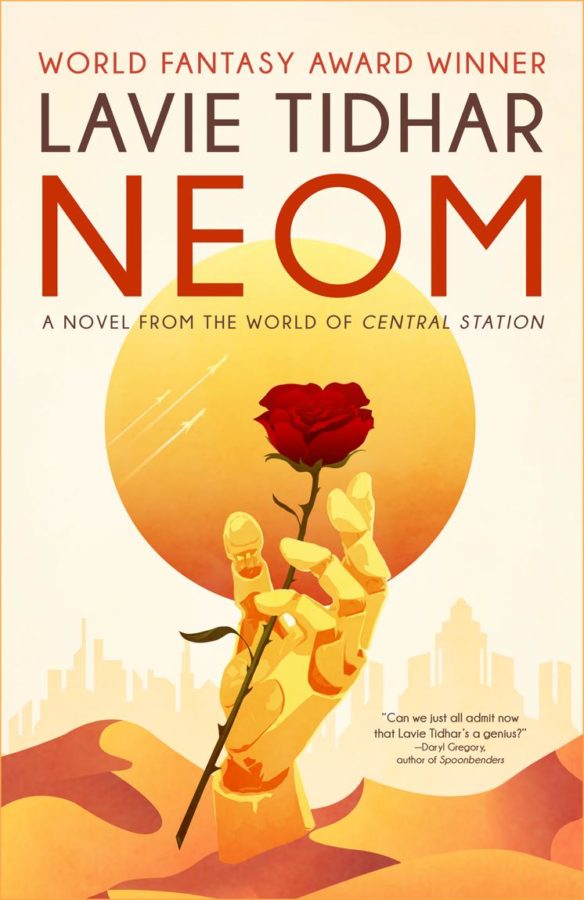
By Paul Weimer: Lavie Tidhar’s Neom is a stunning return to his world of Central Station, twinning the fates of humans and robots alike at a futuristic city on the edge of the Red Sea.
There has been a town at the place called Tabuk for hundreds of years, possibly as much as two thousand. In the future of Lavie Tidhar’s novel, that town has become, grown and become a mecca for technology and industry, a city of the future, not far away from the dangers of the desert, and the glamour and connections of Central Station. A place built on capital and money, a place built on the idea that anything can be fixed, can be improved, can be made better. A place with the promise of a new world that can be just as real, if not more so, than the world that has come before. A sprawling metropolis, glittering near the Red Sea.
This is Neom. This book is the city’s story.
No, that’s not right.
Meet The Golden Man. The Golden Man is a robot. You can’t quite meet The Golden Man yet because the Golden Man is broken, dead in fact. But with the right person to repair him, and with the right power source, the Golden Man might be called forth again. Events, fate, might conspire to bring the people with the right talents, and the right tech to bring together a robot who might command other robots–all the other robots sleeping, buried, lost in the wilderness of desert and the bottom of the Red Sea. A lot of robots, left over from many wars. What might happen when the Golden Man awakes?
This book is that robot’s story.
No that’s not right either.
Trying to describe the novel in terms of a single story, or a single character not only isn’t accurate, but it defeats the beauty and the power of the story that Tidhar is telling here. Neom is an overlaying set of narratives that hand off with each other, with characters that meet, bifurcate, meet again and all roads eventually end at the aforementioned city. Characters both human, robot, young, ancient, human and relatable, and the otherness of the non-human robots. Wait, no. that’s not right, either. Some of the humans and what they have done, and what they have done is extremely alien.
Take the terrorartists, with their weapons that created art, deadly art in the midst of spreading terror and destruction. Understanding the motives, much less the actual technology that they use, is an exercise in trying to understand the Other. Take the Robotnik nest of Dahab. One, or two wars ago it was a haven for robots. In the fourth war, it suffered a terrorartist attack, and the entire city is suspended and held in an explosion frozen in time, continually going on and on. One of our main characters, a young boy named Saleh, lost his father and uncle in an expedition into the city looking for artifacts and goods to plunder and sell. And it is the object that he carries with him from that tragic expedition gone wrong that could decide the fate of Neom, and beyond.
All the book works like this. The Terrorartist who comes to Neom, Nasu. Elias, the caravaneer. The giant mecha named Esau. Mukhtar, owner of the Bazaar of Rare and Exotic Machines, who always makes tea for his customers and guests, human and robot alike. And others. All of their stories intersect and intertwine and we get to spend time with them, like having a coffee in a cafe with a friend who always has something interesting to say in the next sentence. Stories woven together until they come to a conclusion. I’ve heard the idea of “braided narrative” and that is the technique that Tidhar employs here, using his city of the future as the backdrop for (almost all of it).
And let’s talk about the future that Tidhar describes. It’s an Earth of a future indeterminate, Tidhar is not a writer who fusses with dates and extremely detailed visions. It’s a Middle Eastern future, a multicultural future, a future where history has happened between then and now, but some things remain and are always the same. The hints of the future history are tantalizing in his worldbuilding. Every corner of Neom has something new, like a robotic four armed preacher entreating passerby to seek salvation in the zero-point field. The mysterious Yiwu lottery. Martian Soap Operas.
But what does this book remind me of, besides other work by Tidhar (and not just Central Station)? It’s a vision of the future that makes me think of George Alec Effinger, and Lyda Morehouse, and Tim Maughan, among others. In the afterword, Tidhar calls out the Instrumentality of Mankind by Cordwainer Smith and I can see that influence at work, too. The fragmentary, small pieces of future worldbuilding, like the ones I mentioned here. Tidhar’s worldbuilding is not walls of text explaining the First War, or every Terrorartist attack, or a map of Neom, but it is fragments, glimpses that are written with such verve and power that they expand exponentially, bringing a world, a history to life. Tidhar’s fiction makes you think, it pokes, it prods you, and in the end it makes you, through all of the speculation, and the futurism, it makes you feel for the characters, especially when those characters really don’t look like you or think like you.
No, that’s not right. This is a book of hearts and of the heart, be it human or robot, and that is something that is universal, be it ourselves or in “the other”. The “other”, in Tidhar’s work, is us, and we are the other. We are all us, and in Neom, we feel for that other, in the personage of the robots, in the human characters, and we take them, and their stories, into us.
Now that, that is right.
Neom, by Lavie Tidhar (2022, Tachyon Publications)
(1) BRAM STOKER LOSERS UNITE. Scott Edelman has famously lost many Bram Stoker Awards – and he has the card to prove it. He invites tonight’s unlucky nominees to become card-carrying members of this group.
Tonight’s Bram Stoker awards ceremony means — there will be winners — but also losers. If any of the new Never Winner losers created tonight would like this Susan Lucci of the HWA to mail you one of my “It is an honor to be nominated” cards — ask, and one will be sent your way!
However — if you’re a previous Never Winner in Denver tonight who already owns of one of these cards and should lose yet again — please track down Lee Murray, whom I have deputized to punch you a new hole. Good … luck?
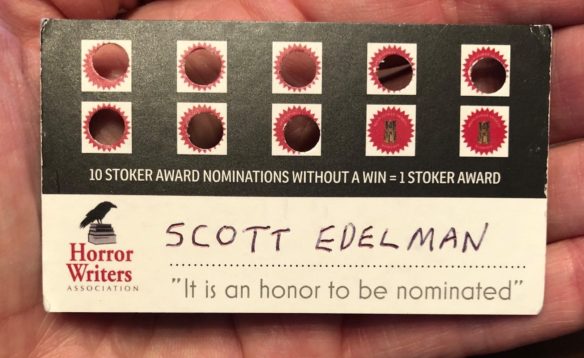
(2) LIVE LONG ENOUGH, YOU’LL PROSPER. Somtow Sucharitkul tells Facebook readers why a recent Star Trek episode rang a bell. BEWARE SPOILERS.
SPOILER COMING – But For What Exactly?
The Enterprise discovers that a comet is hurtling toward a planet that doesn’t have warp drive and whose civilization they cannot interfere with because of the prime directive. Presently, they discover that the comet is alive, and has some kind of intelligence. The only way to save the planet is to find a way to communicate with the comet, and it turns out that the key is to sing to it a folk song from someone’s homeworld….
Yes, this is the plot of the new episode of Star Trek: Strange New Worlds, but it’s also the plot of my 2001 Star Trek Novel, “Do Comets Dream?” which is itself vaguely adapted from a tale told in my Inquestor series, “The Comet That Cried for Its Mother”, originally published in AMAZING….
(3) IT’S A MASSACRE. “Everything on Broadcast TV Just Got Canceled” Vanity Fair declared yesterday. It will feel like that if you watched sff on CW.
In the ever-changing television landscape, this past Thursday was a particularly tough time to be a broadcast television show. Per TV Guide, 17 broadcast television shows were officially given the axe by their respective networks yesterday. “It’s the Red Wedding at WBTV/CW today,” tweeted showrunner Julie Plec, whose CW shows Legacies and Roswell, New Mexico were both among the carnage. “Much more to say, but not today. Loads of gratitude coming for fans and cast and crew in future tweets. But today, we mourn.”
The CW was hit particularly hard, with nine shows getting chopped in all. Along with Legacies and Roswell, New Mexico, the teen-focused network said goodbye to Dynasty after five seasons, In The Dark after four seasons, and Batwoman after three seasons. The network is currently up for sale, which may explain why it was particularly ruthless with its cancellations and downsizing its slate from 19 original scripted series to 11 original scripted series ahead of next fall….
(4) WHAT’S IT ALL ABOUT, ALFIE? James Wallace Harris reprints and analyzes Alfred Bester’s vintage analysis of the genre in “Blows Against The Empire: Alfred Bester’s 1953 Critique of Science Fiction” at Classics of Science Fiction (a 2020 post).
…Bester is looking back over what many have called the Golden Age of Science Fiction and burning it down with his blaster. I wish I could find the fan reaction to this essay from back in the 1950s, but Google only returns seven results. And for those who aren’t familiar with the name Alfred Bester, he wrote two books in the 1950s that became classics: The Stars My Destination and The Demolished Man. At the time Bester had a reputation for being a writing stylist and innovator. So getting a dressing down from one of our own must have been painful.
I wonder what I would have thought if I read and understood this essay in 1962 when I first began reading science fiction. Science fiction wasn’t popular then like it is today. Science fiction was one step up from comic books, and you were called retarded (their word back then) by your peers if you read comics. I remembered also being called a geek and zero for reading SF. Back then those terms were the social kiss of death. I had two buddies that read science fiction in high school and I remember being very hurt by George’s mother when she sat is down one day and gave us a serious talk about evils of reading science fiction. George’s mother was a sophisticated, well-educated, widely traveled woman, and I was always impressed with her thoughts, so it really hurt when she tried to convince us we were reading trash. She implied reading SF was a sign we were emotionally and intellectually immature. We thought we were Slans…
(5) OPPOSING BOOK BANS. “More than 25 Organizations Join ALA’s ‘Unite Against Book Bans’ Campaign”. Among them are the Authors Guild and Comic Book Legal Defense Fund.
The American Library Association this week announced that more than 25 major organizations, including a host of publishers and author and bookseller groups, have joined its Unite Against Book Bans campaign, an effort to help communities defend the freedom to read. The ALA launched the campaign in April to raise awareness about the surge in book bans and other legislation targeting the work of schools and libraries, with support from the Steve and Loree Potash Family Foundation and the William and Flora Hewlett Foundation.
“Our partners and supporters are critical in moving the needle to ultimately bring an end to book bans,” said Deborah Caldwell-Stone, director of the ALA’s Office for Intellectual Freedom. “It’s time that policymakers understand the severity of this issue. ALA is taking the steps necessary to protect individuals’ access to information, but we can’t do this alone.”…
“Three-quarters of the 1,100 plus books currently banned in public schools in the United States have been written by authors of color, LGBTQ authors, or other traditionally marginalized voices,” said Authors Guild CEO Mary Rasenberger, in a statement.

(6) NAMING CONVENTIONS. He has a point –
(7) PERSONAL TAXONOMY. Joe Vasicek, often quoted here in the Sad Puppy days of 2015, shares what he calls “an interesting personal discovery” at One Thousand And One Parsecs.
…I just made a very interesting personal discovery, gleaned from the data on my reading of the Hugo and Nebula winning books. Of the 110 novels that have won either award, I have now read all but 16 of them, which is enough data to get some representative results.
One of the best predictors that I will DNF a book is whether the author is a childless woman. Of the 18 books written by childless women, I have DNFed all but three of them (Downbelow Station by C.J. Cherryh, which I read years ago and would probably DNF today, and Network Effect by Martha Wells, which is a genuinely entertaining read, and Jonathan Strange & Mr. Norell by Susanna Clarke, which I haven’t read yet). For childless men, it’s a little bit more of a crapshoot: of the 31 books written by childless men, I’ve DNFed 16 of them and read 11, but only 6 of those are books I thought were worth owning.
Conversely, one of the best predictors that I will enjoy a book is whether the author is a mother. Of the 20 books written by mothers, I have DNFed only 6 of them and read 8, all of which I think are worth owning. Of the six remaining books that I haven’t read yet, I will almost certainly finish four of them, and may finish all six. The only book by an author I haven’t already read and enjoyed is The Speed of Dark by Elizabeth Moon, which I am currently reading and will probably finish next week…
(8) LIGHT MY FIRE. “Firestarter (2022) vs. Firestarter (1984): Which Stephen King adaptation burns brightest?” – Clark Collis supplies his answer at Entertainment Weekly. The summaries of each film make good reading, too.
… The 1984 film stars Barrymore as Charlie McGee, a young girl with pyrokinetic powers who is fleeing from a sinister government organization called “The Shop” with her father Andy, played by David Keith. Andy has been training Charlie to use her powers properly by getting her to turn bread into toast with her mind but it is the unfortunate Shop agents who get browned as Barrymore’s character periodically sets them ablaze. The supporting cast is notable for a few reasons. Oscar-winners Art Carney and Louise Fletcher play a couple who befriend Charlie and Andy, while Martin Sheen portrays the head of the Shop just a year after his performance in David Cronenberg’s adaptation of King’s The Dead Zone. Finally, another Academy Award-winner, George C. Scott, is inexplicably cast as the seemingly First Nation assassin John Rainbird, who has a fondness for punching his targets’ noses into their brains and an unhealthy interest in our heroine…
(9) TOM SWIFT. Edge Media Network supplies an intro as “First Trailer Drops for New CW Series ‘Tom Swift’ Featuring a Black Gay Lead Character”.
…”Tian Richards already made his debut as Tom Swift on one of the best episodes of ‘Nancy Drew’ yet, but get ready to see him in a whole new light on his own show,” EW said.
As previously reported at EDGE, being gay was a prominent part of the character’s depiction when he made a guest appearance on “Nancy Drew.” Sparks flew between Tom Swift and “Nancy Drew” regular character Nick (Tunji Kasim), leading to an onscreen kiss….
(10) WHEN I USE A WORD. At Tor.com, CD Covington’s series on sff linguistics finally tackles the 500-lb gorilla: “On Tolkien, Translation, Linguistics, and the Languages of Middle-earth”.
Since I started this column in 2019, I’ve been avoiding one famous—possibly even the most famous—example of using linguistics in SFF literature: the work of J.R.R. Tolkien. It’s not because I don’t like Lord of the Rings—quite the opposite, in fact. It’s just such an obvious topic, and one which people have devoted decades of scholarship to exploring. Hell, my Old English prof has published academic scholarship on the topic, in addition to teaching a Maymester class on the languages of Middle-earth. But I suppose it’s time to dedicate a column to the book that first made me think language was cool and to the man who wrote it.
(11) MEDIA BIRTHDAY.
2010 – [By Cat Eldridge.] I’m starting this essay by acknowledging that everyone has their favorite Robin Hood. My all-time favorite is the one in the Robin of Sherwood series, Robin of Loxley as played by Michael Praed. And yes, I acknowledge that the second Robin, Robert of Huntingdon as performed by Jason Connery was quite excellent too. Richard Carpenter did himself proud with this series.
But I’m here tonight to talk about one of my favorite Robin Hood films (the other being Robin and Marian.) Ridley Scott’s Robin Hood premiered in the States on this date twelve years ago. It was written by Brian Helgeland who had done mostly horror films before this but was also the screenwriter of the beloved A Knight’s Tale. He along with Ethan Reiff and Cyrus Voris were responsible for the story.
It was produced by Ridley Scott, Brian Grazer and Russell Crowe. Yes the actor who played Robin Hood here helped produce it. So let’s turn to casting.
I think Crowe made an outstanding Robin Longstride and Cate Blanchett as Marion Loxley was a great casting move. Other interesting casting here includes Max von Sydow as Sir Walter Loxley and William Hurt as William Marshal. This was not a cast of unknowns. I thought Matthew Macfadyen as the Sheriff of Nottingham was interesting as the actor usually had much lighter roles. Mark Addy as Friar Tuck was well cast.
It was a very expensive undertaking costing at least two hundred million and it took in least three hundred and twenty-five million, so it likely just broke even.
And what was the opinion of critics at the time? Well it was decidedly mixed with Deborah Ross of UK’s Spectator on the side of the dissenters: “Scott decided, I think, to get away from the whole campy thing in tights business and wanted to make this ‘real’. So there is sweat and dirt and rats at the cheese and even bad teeth, which is fair enough, but it is also joyless.”
But Richard Klein of Shadows on the Wall liked it: “Ridley Scott and his usual Oscar-winning crewmates turn the familiar old English legend it into a robust, thumping epic. The pacing is a bit uneven, but it keeps us thoroughly engaged.”
Let’s finish off with Jeffrey Westhoff of the Northwest Herald: “Robin Hood doesn’t become the swashbuckling bandit of Sherwood until the final moments, when the tag “And so the legend begins” appears. You may walk away liking this Robin Hood well enough, but wishing you had seen the sequel.”
It gets just a fifty eight percent rating among audience reviewers at Rotten Tomatoes.

(12) TODAY’S BIRTHDAYS.
[Compiled by Cat Eldridge.]
(13) COMICS SECTION.
(14) CLUES OF THE DAY. [Item by Martin Morse Wooster.] Keith Roysdon remembers newspaper crime comic strips (remember Steve Roper and Mike Nomad?) “Black and White and Noir All Over: A Brief History of Vintage Newspaper Crime Comic Strips” at CrimeReads.
Who could have known that newspaper comic strips and crime stories, including noir, were a match made in heaven?
Newspaper comic strips are an artistic genre that’s largely forgotten now. The strips that remain are for the most part humor strips like “Garfield.” A handful of dramatic strips are still published.
But serial dramatic strips were once a staple of the newspaper comics page. Many of them were soap opera-ish strips like “Mary Worth” and “Apartment 3-G.” To say that drama strips were slow moving is an understatement. I wish I could remember who joked that they came back to read “Apartment 3-G” after decades away and the caption read, “Later that afternoon …”
But that deliberate pace – well, maybe not quite that deliberate – was perfect for teasing out a good crime storyline. And crime and noir look awesome in black and white newsprint.
(15) MUSIC WITHOUT THE SPHERES. “Peace is Still Weirder Than War” asserts Laurie Penny in a very entertaining essay about Eurovision. Admittedly, nothing to do with sff except a brief reference to Catherynne M. Valente’s Space Opera at the end.
…Britain is a lot worse at Eurovision than you’d think. We’ve spent half a century distracting the world from our post imperial decline by flinging out wild handfuls of pop music and self deprecating humour, so we really ought to be able to deploy them here. Sadly, we’re scuppered every time by our even more fundamental fear of looking daft in front of the French.
We’ve made worse choices for the same reason.
But reasons are not excuses, and the land of Monty Python, David Bowie and the Bonzo Dog Doo-Dah Band should be able to do better than another basic bearded guitar boy. We do have the best tv commentary by miles, after Graham Norton seamlessly accepted the baton from the great Terry Wogan, proving once again that Britain’s comfort zone is making fun of other people. Yes. Hi.
…For related reasons, Ukraine are likely to win this year. Russia can sulk all they like, just like they did when Ukraine stood down from Eurovision in 2015with the reasonable excuse that they were busy being invaded by Russia. in 2016, Ukraine was back, and it won, narrowly beating Russia, whose entry looked like someone repurposed a rave club as a re-education camp without redecorating. Not only did Ukraine win, it won with a song called ‘1944’, about the Soviet genocide of the Crimean Tartars. Russia has not forgotten this. State Television spent a long time denouncing Eurovision as a degenerate spectacle of homosexuality, which did as much good as denouncing bears for defecating in the woods.
But Russia has never really been any good at Eurovision. This year they’re not even going, partly because the Kremlin has no interest in any competition it can’t cheat at, but mostly because they got banned. It’s hard to get banned from Eurovision, but invading a neighboring country and massacring tens of thousands of people will do the trick….
(16) STOP, NOW, WHAT’S THAT SOUND? ScreenRant suggests “10 ‘Subtly’ Scary Horror Movies (For Horror Fans Sick Of Jump Scares)”. A Bradbury adaptation leads the list!
Sometimes the unknown or the unnatural can be much more terrifying than any masked slasher with a chainsaw.
….It’s not so much that these films rely on someone hiding in the shadows and yelling boo, but rather the audience knows something is wrong but can’t identify what. While jump scares and other such tactics might be sparsely employed, the real horror in these movies comes from both knowing and not knowing what might be in store.
Something Wicked This Way Comes (1983)
Sometimes, the scariest movies are the ones where nobody dies, and Disney’s Something Wicked This Way Comes is a brilliant example. Based on the book by Ray Bradbury, the film tells the story of what happens when a mysterious carnival lurks into town one windy October.
Led by the mysterious Mr. Dark, Cooger and Dark’s Shadow Show has the uncanny ability to grant anyone’s wishes and make their dreams come true. But like with most things Disney, all magic comes at a price. When two boys and the local librarian are able to see through the illusions, a slow-burning battle with the freakshow for the souls of the town takes place.
(17) THE HUNDREDTH SHADE. Paul Weimer reviews “Gregory A. Wilson’s Grayshade” at A Green Man Review.
… We meet Grayshade in the midst of an assassination that doesn’t go quite to plan, and a relatively atypical assassination target at that – the outwardly flighty socialite wife of a political powerful man, which in itself seems odd to Grayshade. We come to Grayshade at a point in his career where he is extremely experienced and very good at what he does. This is no “coming of age” novel where we follow the assassin through his first mission; rather this is someone who has past adventures and missions behind him, which grounds him for when things do not go according to his expectations. Things spiral out from the assassination not going right, to the point where Grayshade starts to question his purpose, his role, and the entire Order.
This makes a lot of the novel about information control and dissemination, which in turn reminds me of Wilson’s gamemastering….
(18) BAD BACK TO THE FUTURE. At Galactic Journey, Jessica Holmes gives us an recap of the latest (in 1967!) episode of Doctor Who. “[May 14, 1967] Ben And Polly To The Departure Gate (Doctor Who: The Faceless Ones [Part 2])”.
…We left things off with the Doctor having a sudden attack of a bad back, and things only get worse, with Spencer disabling Jamie and Samantha within moments of the episode’s opening.
Now would be a good time to finish them off, you’d think, but instead he sets up some sort of death ray to kill them… eventually. The thing moves so slowly the trio would probably have time for a round of golf before the ray fries them. Though mostly paralysed, Samantha conveniently has enough control of her faculties to get her mirror from her bag and hand it to Jamie, who uses it to reflect the beam and blow up the death ray machine.
With the machine destroyed, their partial paralysis wears off, which doesn’t make an awful lot of sense to me. I thought it was the freezing pen that paralysed them? And I’m still not sure what that device on the Doctor’s back did to him…
(19) AND YOU ARE THERE. This fossil is in a way a snapshot: “How the dinosaurs died: New evidence In PBS documentary” – the Washington Post digs into the story.
…The ground started shaking with intense vibrations while water in the nearby sea sloshed about in response. The sky filled with burning embers, which drifted down and set fire to the lush primordial forest.
Thescelosaurus panicked and looked to flee — but it was too late. Everything changed in a heartbeat as a 30-foot-high wave of mud and debris came racing up the seaway from the south, sweeping away life and limb in the process. The dinosaur was caught in the destructive deluge, its leg ripped off at the hip by the devastating surge.
That moment — 66 million years ago at the end of the Cretaceous period, when an earth-shattering asteroid ended the reign of the dinosaurs — is frozen in time today through a stunning fossil found last year at the Tanis dig site in North Dakota. This perfectly preserved leg clearly shows the skin, muscle and bones of the three-toed Thescelosaurus.
While the details of the death scenario described above are embellished, they’re based on remarkable new findings and accounts by Robert DePalma, lead paleontologist at Tanis.
“We’re never going to say with 100 percent certainty that this leg came from an animal that died on that day,” the scientist said. “The thing we can do is determine the likelihood that it died the day the meteor struck. When we look at the preservation of the leg and the skin around the articulated bones, we’re talking on the day of impact or right before. There was no advanced decay.”…
(20) DRAWN WITHOUT DRAWERS. CBR.com remembers: “Star Wars: Why George Lucas Had to Fight for Chewbacca Not to Wear Shorts”.
…So he wanted McQuarrie to go beyond humanoid and try to do more of an animal design for Chewbacca. Lucas’ recall led him to a recent issue of Analog Magazine, which had a short novel in it by a pre-Game of Thrones George R.R. Martin called “And Seven Times Never Kill a Man.” Artist John Schoenherr had designed some characters for Martin’s story and they made it to the cover of the magazine…
Lucas sent the drawings to McQuarrie and basically said, “Draw Chewbacca like that” and so that’s what McQuarrie did…
The problem with having basically a giant dog as a character is that dogs, well, you know, don’t have pants. McQuarrie kept coming up with some designs with the character in pants and Lucas kept saying no and that carried over to when the film started production. Lucas’ specific vision of what Chewbacca would look like required him to not have pants and that was a bit of a strange thing for the studio executives at the time.
During the DVD commentary for the 2004 release of Star Wars on DVD, Mark Hamill recalled what Lucas had to go through with regard to Chewbacca’s lack of clothes. “I remember the memos from 20th Century Fox. Can you put a pair of lederhosen on the Wookiee?’ All they could think of was, ‘This character has no pants on!’ This went back and forth. They did sketches of him in culottes and baggy shorts.”…
(21) BEING SNARKY. Would Lewis Carroll readers with an unassigned two hours or so available be interested in the opportunity to watch this complete production? “The Hunting of the Snark” posted by Official London Theatre.
[Thanks to Andrew Porter, Michael Toman, Cat Eldridge, Mike Kennedy, Martin Morse Wooster, JJ, John King Tarpinian, and for some of these stories. Title credit belongs to File 770 contributing editor of the day Soon Lee.]